Top Challenges in Customer Journey Mapping & How to Mitigate them in 2021
With sky-rocketing demands of tech-savvy customers, the pandemic has spurred the growth of digital channels and led to businesses prioritizing customer journey mapping to deliver seamless digital experiences.
A recent research by Salesforce on the state of customer experience reveals that 80% of customers consider CX equally important to the kind of products or service offered by the company.
In the new normal, customer journey mapping has emerged as a pre-requisite for analyzing customer expectations and delivering personalized customer experiences across all touchpoints. Cross-device and multiple-channel access of services has made mapping customer journey a tedious task for businesses.
In this blog we will discuss the top challenges brands face while mapping their customer journey and the ways to overcome them in 2021:
1. Complex Web of Multiple Channels
Proliferation of multiple channels, devices and evolving technologies have made the purchase funnel a complex web making it difficult to identify and track the influence of touchpoints on the customer. It has become even more difficult for brands to decipher whether the customer has been converted or not.
How to mitigate : It is thus important for brands to identify, track and map customer behavior and preference patterns to gain key insights into the different paths your customers take towards the final purchase. Brands need to leverage the power of analytical tools to visualize and quantify the buyer's journey. Integrating the analytical capabilities with your content strategy will help you leverage data for customer engagement at the right place and at the right time.

2. Monitoring User Behavior Across Channels
Customer journey involves a wide range of activities across multiple channels and devices like a mobile application, reviews on the internet or brand communication on a social media channel and much more. Capturing these cross-channel activities through existing technologies, departments and processes and then responding to the customers with relevant and personalized content is a challenge.
How to mitigate : Brands need to leverage a unified and central solution by breaking down departmental silos and processes to create a more collaborative model which can help analyze the customer journey across channels. System integrations and data unification across all touchpoints-digital, web, emails or social media platforms can help you deliver personalized brand communication across all customer touchpoints.
3. Mapping Every Buyer Persona in a Single Map
Trying to map every buyer persona in a single customer journey map makes it both complicated and misleading. Every buyer persona targets a set of audience with unique pain points, buying patterns, behaviors and path to purchase.
How to mitigate : Brands must design a map that targets every unique buyer persona. Creating standalone visualizations for your customers helps you target your content planning and personalization strategies to elevate customer experience.
4. Missing the Moments of Customer Silence
The real challenge for marketers during their customer journey mapping strategy is identifying the point of abandonment, denial and silence of customers. Most companies fail to capture and track these moments of silence which often leads to the eventual loss of customer satisfaction and loyalty.
How to mitigate : Brands need to identify these moments of silence and track the reasons for such inactivity. It is imperative to ask relevant questions like - why are customers abandoning the process and why are they dropping? What systems, supports and integrations can be created to factor in these disengagements and how can we create relevant content and personalized communication to improve customer engagements.
Customer Journey Mapping : Elevate CX in 2021 & Beyond
Businesses must identify the pain points of customers and be proactive in communicating with them at the right time with tailor-made solutions to meet their expectations.
With the right technology solutions and partners, you can push the customer mapping barriers and orchestrate the right customer experience for your buyers. Do you want to see how a real Customer Journey Map looks like? Do you need to design a Customer Journey Mapping tool to help streamline your customer experience initiatives and track all your customer touchpoints?
You can reach out to us to understand and develop the fundamental metrics to identify customer touchpoints across all devices and create the right avenues to engage with your customers for driving better business value and attain higher ROI. Get an in-depth look at our investigation process and how it helped our customers define the course of their products. Reach out to us at [email protected] for your queries.

Subscribe To Our Blog
By clicking on "SUBSCRIBE NOW" you acknowledge having read our Privacy Notice.
Let's get you started on the digital-first & transformation journey. Reserve your free consultation or a demo today!
© 2024, Espire Infolabs Pvt. Ltd. All Rights Reserved
Privacy Policy
Privacy Notice
Customer Journey Maps: How to Create Really Good Ones [Examples + Template]
Updated: April 17, 2024
Published: May 04, 2023
Did you know 70% of online shoppers abandoned their carts in 2022? Why would someone spend time adding products to their cart just to fall off the customer journey map at the last second?

The thing is — understanding your customer base can be very challenging. Even when you think you’ve got a good read on them, the journey from awareness to purchase for each customer will always be unpredictable, at least to some level.

While it isn’t possible to predict every experience with 100% accuracy, customer journey mapping is a convenient tool for keeping track of critical milestones that every customer hits. In this post, I’ll explain everything you need to know about customer journey mapping — what it is, how to create one, and best practices.
Table of Contents
What is the customer journey?
What is a customer journey map, benefits of customer journey mapping, customer journey stages.
- What’s included in a customer journey map?
The Customer Journey Mapping Process
Steps for creating a customer journey map.
- Types of Customer Journey Maps
Customer Journey Mapping Best Practices
- Customer Journey Design
- Customer Journey Map Examples
Free Customer Journey Map Templates
.webp)
Free Customer Journey Template
Outline your company's customer journey and experience with these 7 free templates.
- Buyer's Journey Template
- Future State Template
- Day-in-the-Life Template
You're all set!
Click this link to access this resource at any time.
The customer journey is the series of interactions a customer has with a brand, product, or business as they become aware of a pain point and make a purchase decision. While the buyer’s journey refers to the general process of arriving at a purchase, the customer journey refers to a buyer's purchasing experience with a specific company or service.
Customer Journey vs. Buyer Journey
Many businesses that I’ve worked with were confused about the differences between the customer’s journey and the buyer’s journey. The buyer’s journey is the entire buying experience from pre-purchase to post-purchase. It covers the path from customer awareness to becoming a product or service user.
In other words, buyers don’t wake up and decide to buy on a whim. They go through a process of considering, evaluating, and purchasing a new product or service.
The customer journey refers to your brand’s place within the buyer’s journey. These are the customer touchpoints where you will meet your customers as they go through the stages of the buyer’s journey. When you create a customer journey map, you’re taking control of every touchpoint at every stage of the journey instead of leaving it up to chance.
For example, at HubSpot, our customer’s journey is divided into three stages — pre-purchase/sales, onboarding/migration, and normal use/renewal.

1. Use customer journey map templates.
Why make a customer journey map from scratch when you can use a template? Save yourself some time by downloading HubSpot’s free customer journey map templates .
This has templates that map out a buyer’s journey, a day in your customer’s life, lead nurturing, and more.
These templates can help sales, marketing, and customer support teams learn more about your company’s buyer persona. This will improve your product and customer experience.
2. Set clear objectives for the map.
Before you dive into your customer journey map, you need to ask yourself why you’re creating one in the first place.
What goals are you directing this map towards? Who is it for? What experience is it based upon?
If you don’t have one, I recommend creating a buyer persona . This persona is a fictitious customer with all the demographics and psychographics of your average customer. This persona reminds you to direct every aspect of your customer journey map toward the right audience.
3. Profile your personas and define their goals.
Next, you should conduct research. This is where it helps to have customer journey analytics ready.
Don’t have them? No worries. You can check out HubSpot’s Customer Journey Analytics tool to get started.
Questionnaires and user testing are great ways to obtain valuable customer feedback. The important thing is to only contact actual customers or prospects.
You want feedback from people interested in purchasing your products and services who have either interacted with your company or plan to do so.
Some examples of good questions to ask are:
- How did you hear about our company?
- What first attracted you to our website?
- What are the goals you want to achieve with our company? In other words, what problems are you trying to solve?
- How long have you/do you typically spend on our website?
- Have you ever made a purchase with us? If so, what was your deciding factor?
- Have you ever interacted with our website to make a purchase but decided not to? If so, what led you to this decision?
- On a scale of 1 to 10, how easily can you navigate our website?
- Did you ever require customer support? If so, how helpful was it, on a scale of 1 to 10?
- Can we further support you to make your process easier?
You can use this buyer persona tool to fill in the details you procure from customer feedback.
4. Highlight your target customer personas.
Once you’ve learned about the customer personas that interact with your business, I recommend narrowing your focus to one or two.
Remember, a customer journey map tracks the experience of a customer taking a particular path with your company. If you group too many personas into one journey, your map won’t accurately reflect that experience.
When creating your first map, it’s best to pick your most common customer persona and consider the route they would typically take when engaging with your business for the first time.
You can use a marketing dashboard to compare each and determine the best fit for your journey map. Don’t worry about the ones you leave out, as you can always go back and create a new map specific to those customer types.
5. List out all touchpoints.
Begin by listing the touchpoints on your website.
What is a touchpoint in a customer journey map?
A touchpoint in a customer journey map is an instance where your customer can form an opinion of your business. You can find touchpoints in places where your business comes in direct contact with a potential or existing customer.
For example, if I were to view a display ad, interact with an employee, reach a 404 error, or leave a Google review, all of those interactions would be considered a customer touchpoint.
Your brand exists beyond your website and marketing materials, so you must consider the different types of touchpoints in your customer journey map. These touchpoints can help uncover opportunities for improvement in the buying journey.
Based on your research, you should have a list of all the touchpoints your customers are currently using and the ones you believe they should be using if there’s no overlap.
This is essential in creating a customer journey map because it provides insight into your customers’ actions.
For instance, if they use fewer touchpoints than expected, does this mean they’re quickly getting turned away and leaving your site early? If they are using more than expected, does this mean your website is complicated and requires several steps to reach an end goal?
Whatever the case, understanding touchpoints help you understand the ease or difficulties of the customer journey.
Aside from your website, you must also look at how your customers might find you online. These channels might include:
- Social channels.
- Email marketing.
- Third-party review sites or mentions.
Run a quick Google search of your brand to see all the pages that mention you. Verify these by checking your Google Analytics to see where your traffic is coming from. Whittle your list down to those touchpoints that are the most common and will be most likely to see an action associated with it.
At HubSpot, we hosted workshops where employees from all over the company highlighted instances where our product, service, or brand impacted a customer. Those moments were recorded and logged as touchpoints. This showed us multiple areas of our customer journey where our communication was inconsistent.
The proof is in the pudding — you can see us literally mapping these touch points out with sticky notes in the image below.

Don't forget to share this post!
Related articles.
![customer journey mapping challenges How AI Image Misuse Made a World of Miscommunication [Willy's Chocolate Experience]](https://blog.hubspot.com/hubfs/ai%20image%20misuse%20the%20willy%20wonka%20experience%20%281%29.png)
How AI Image Misuse Made a World of Miscommunication [Willy's Chocolate Experience]

7 Ways to Delight Your Customers This Holiday Season

14 Customer Experience Fails that Companies Can Learn From
![customer journey mapping challenges How Customer Experience Has Evolved Over the Last Decade [+ 2024 Trends]](https://blog.hubspot.com/hubfs/future-of-customer-experience.png)
How Customer Experience Has Evolved Over the Last Decade [+ 2024 Trends]
![customer journey mapping challenges Memorable Examples of AR in Customer Experience [+Tips for Implementing the Technology]](https://blog.hubspot.com/hubfs/augmented%20reality%20customer%20experience.png)
Memorable Examples of AR in Customer Experience [+Tips for Implementing the Technology]

Digital Customer Experience: The Ultimate Guide for 2023
![customer journey mapping challenges How to Implement a Hybrid Customer Service Strategy That Works [Expert Tips]](https://blog.hubspot.com/hubfs/hybrid%20customer%20service_featured.png)
How to Implement a Hybrid Customer Service Strategy That Works [Expert Tips]

User Flows: 8 Tips For Creating A Super Smooth User Experience

11 Best Practices for B2B Customer Experience
![customer journey mapping challenges Customer Experience vs. User Experience: What’s the Difference? [+ Examples]](https://blog.hubspot.com/hubfs/customer-experience-vs-user-experience_2.webp)
Customer Experience vs. User Experience: What’s the Difference? [+ Examples]
Outline your company's customer journey and experience with these 7 free customer journey map templates.
Service Hub provides everything you need to delight and retain customers while supporting the success of your whole front office
Customer Journey Mapping
Journey mapping helps you visualize how customers experience your product or service, and how they feel along the way. Scroll to step 6 for a real-life example from one of our product teams!
USE THIS PLAY TO...
Understand the customer journey from a specific persona's perspective so that you can design a better experience.

Running the play
Depending on how many touchpoints along the customer journey you're mapping, you might break the journey into stages and tackle each stage in pairs.
Sticky notes
Whiteboards.io Template
Define the map's scope (15 min)
Ideally, customer journey mapping focuses on the experience of a single persona in a single scenario with a single goal. Else, the journey map will be too generic, and you'll miss out on opportunities for new insights and questions. You may need to pause creating a customer journey map until you have defined your customer personas . Your personas should be informed by customer interviews , as well as data wherever possible.
Saying that, don't let perfect be the enemy of good! Sometimes a team just needs to get started, and you can agree to revisit with more rigor in a few months' time. Once scope is agreed on, check your invite list to make sure you've got people who know the details of what customers experience when using your product or service.
Set the stage (5 min)
It's really important that your group understands the user persona and the goal driving their journey. Decide on or recap with your group the target persona and the scope of the journey being explored in your session. Make sure to pre-share required reading with the team at least a week ahead of your session to make sure everyone understands the persona, scope of the journey, and has a chance to delve deeper into research and data where needed. Even better- invite the team to run or attend the customer interviews to hear from customers first hand!
E.g. "We're going to focus on the Alana persona. Alana's role is project manager, and her goal is to find a scalable way for her team to share their knowledge so they spend less time explaining things over email. We're going to map out what it's like for Alana to evaluate Confluence for this purpose, from the point where she clicks that TRY button, to the point where she decides to buy it – or not."
Build a customer back-story (10 min)
Have the group use sticky notes to post up reasons why your target persona would be on this journey in the first place. Odds are, you'll get a range of responses: everything from high-level goals, to pain points, to requested features or services. Group similar ideas and groom the stickies so you can design a story from them.
These narratives should be inspired by actual customer interviews. But each team member will also bring a different perspective to the table that helps to broaden the lens.
Take a look at the example provided in the call out of this section. This back story starts with the pain points – the reasons why Alana would be wanting something like Confluence in the first place.
- E.g., "Her team's knowledge is in silos"
Then it basically has a list of requirements – what Alana is looking for in a product to solve the bottom pain points. This is essentially a mental shopping list for the group to refer to when mapping out the customer journey.
- E.g., "Provide structure"
Then it has the outcomes – goals that Alana wants to achieve by using the product
- E.g., "To keep my team focused on their work instead of distracted by unnecessary emails and shoulder-taps"
And finally the highest-level goal for her and her team.
- E.g., "Improve team efficiency"
Round off the back story by getting someone to say out loud what they think the overall story so far is, highlighting the main goals the customer has. This ensures a shared understanding that will inform the journey mapping, and improve the chances that your team will map it from the persona's point of view (not their own).
- E.g., "Alana and her team are frustrated by having to spend so much time explaining their work to each other, and to stakeholders. They want a way to share their knowledge, and organize it so it's easy for people outside their team to find, so they can focus more energy on the tasks at hand."

For example...
Here's a backstory the Confluence team created.
Map what the customer thinks and feels (30-60 min)
With the target persona, back story, and destination in place, it's time to walk a mile in their shoes. Show participants how to get going by writing the first thing that the persona does on a sticky note. The whole group can then grab stickies and markers and continue plotting the journey one action at a time.
This can also include questions and decisions! If the journey branches based on the answers or choices, have one participant map out each path. Keep in mind that the purpose of this Play is to build empathy for, and a shared understanding of the customer for the team. In order to do this, we focus on mapping the current state of one discrete end to end journey, and looking for opportunities for improvement.
To do a more comprehensive discovery and inform strategy, you will need to go deeper on researching and designing these journey maps, which will need to split up over multiple sessions. Take a look at the variation below for tipes on how to design a completely new customer journey.
Use different color sticky notes for actions, questions, decisions, etc. so it's easier to see each element when you look at the whole map.
For each action on the customer journey, capture which channels are used for the interactions. Depending on your context, channels might include a website, phone, email, postal mail, face-to-face, and/or social media.
It might also help to visually split the mapping area in zones, such as "frontstage" (what the customer experiences) versus "backstage" (what systems and processes are active in the background).
Journey mapping can open up rich discussion, but try to avoid delving into the wrong sort of detail. The idea is to explore the journey and mine it for opportunities to improve the experience instead of coming up with solutions on the spot. It's important not only to keep the conversation on track, but also to create an artefact that can be easily referenced in the future. Use expands or footnotes in the Confluence template to capture any additional context while keeping the overview stable.
Try to be the commentator, not the critic. And remember: you're there to call out what’s going on for the persona, not explain what’s going on with internal systems and processes.
To get more granular on the 'backstage' processes required to provide the 'frontstage' customer value, consider using Confluence Whiteboard's Service Blueprint template as a next step to follow up on this Play.

ANTI-PATTERN
Your map has heaps of branches and loops.
Your scope is probably too high-level. Map a specific journey that focuses on a specific task, rather than mapping how a customer might explore for the first time.
Map the pain points (10-30 min)
"Ok, show me where it hurts." Go back over the map and jot down pain points on sticky notes. Place them underneath the corresponding touchpoints on the journey. Where is there frustration? Errors? Bottlenecks? Things not working as expected?
For added value, talk about the impact of each pain point. Is it trivial, or is it likely to necessitate some kind of hack or work-around. Even worse: does it cause the persona to abandon their journey entirely?
Chart a sentiment line (15 min)
(Optional, but totally worth it.) Plot the persona's sentiment in an area under your journey map, so that you can see how their emotional experience changes with each touchpoint. Look for things like:
- Areas of sawtooth sentiment – going up and down a lot is pretty common, but that doesn't mean it's not exhausting for the persona.
- Rapid drops – this indicates large gaps in expectations, and frustration.
- Troughs – these indicate opportunities for lifting overall sentiments.
- Positive peaks – can you design an experience that lifts them even higher? Can you delight the persona and inspire them to recommend you?
Remember that pain points don't always cause immediate drops in customer sentiment. Sometimes some friction may even buold trust (consider requiring verification for example). A pain point early in the journey might also result in negative feelings later on, as experiences accumulate.
Having customers in the session to help validate and challenge the journey map means you'll be more confident what comes out of this session.
Analyse the big picture (15 min)
As a group, stand back from the journey map and discuss trends and patterns in the experience.
- Where are the areas of greatest confusion/frustration?
- Where is the journey falling short of expectations?
- Are there any new un-met needs that have come up for the user type?
- Are there areas in the process being needlessly complicated or duplicated? Are there lots of emails being sent that aren’t actually useful?
Then, discuss areas of opportunity to improve the experience. E.g., are there areas in the process where seven steps could be reduced to three? Is that verification email actually needed?
You can use quantitative data to validate the impact of the various opportunity areas identified. A particular step may well be a customer experience that falls short, but how many of your customers are actually effected by that step? Might you be better off as a team focused on another higher impact opportunity?
Here's a user onboarding jouney map our Engaging First Impressions team created.
Be sure to run a full Health Monitor session or checkpoint with your team to see if you're improving.
MAP A FUTURE STATE
Instead of mapping the current experience, map out an experience you haven't delivered yet. You can map one that simply improves on existing pain points, or design an absolutely visionary amazeballs awesome experience!
Just make sure to always base your ideas on real customer interviews and data. When designing a totally new customer journey, it can also be interesting to map competitor or peer customer journeys to find inspiration. Working on a personalised service? How do they do it in grocery? What about fashion? Finance?
After the mapping session, create a stakeholder summary. What pain points have the highest impact to customers' evaluation, adoption and usage of our products? What opportunities are there, and which teams should know about them? What is your action plan to resolve these pain points? Keep it at a summary level for a fast share out of key takeaways.
For a broader audience, or to allow stakeholders to go deeper, you could also create a write-up of your analysis and recommendations you came up with, notes captured, photos of the group and the artefacts created on a Confluence page. A great way of sharing this information is in a video walk through of the journey map. Loom is a great tool for this as viewers can comment on specific stages of the journey. This can be a great way to inspire change in your organization and provide a model for customer-centric design practices.
KEEP IT REAL
Now that you have interviewed your customers and created your customer journey map, circle back to your customers and validate! And yes: you might learn that your entire map is invalid and have to start again from scratch. (Better to find that out now, versus after you've delivered the journey!) Major initiatives typically make multiple journey maps to capture the needs of multiple personas, and often iterate on each map. Remember not to set and forget. Journeys are rapidly disrupted, and keeping your finger on the pulse of your customer's reality will enable your team to pivot (and get results!) faster when needed.
Related Plays
Customer Interview
Project Poster
Want even more Playbook?
Drop your email below to be notified when we add new Health Monitors and plays.
Thanks! Now get back to work.
Got feedback?
Drop a question or comment on the Atlassian Community site.
Shared understanding
Different types of teams need to share an understanding of different things.
LEADERSHIP TEAMS
The team has a shared vision and collective purpose which they support, and confidence they have made the right strategic bets to achieve success.
Proof of concept
Project teams.
Some sort of demonstration has been created and tested, that demonstrates why this problem needs to be solved, and demonstrates its value.
Customer centricity
Service teams.
Team members are skilled at understanding , empathizing and resolving requests with an effective customer feedback loop in place that drives improvements and builds trust to improve service offerings.

How to Create a Customer Journey Map
%20(3).jpg)
Creating a customer journey map can help you gain a deeper understanding of the steps, interactions, and emotions that a customer experiences as they move through their journey.
In this blog post, we’ll cover what we mean by a journey map, the benefits and challenges, and provide a step-by-step guide to building your own, including free (and editable) templates you can share with your team.
What is a customer journey map?
A customer journey map is a visual representation of the steps and experiences a customer has as they interact with a business, product, or service. It can be used to identify areas of friction, understand customer preferences, and create a personalized experience for each customer.
By creating a customer journey map, businesses can gain insight into how customers move from awareness to purchase, and build meaningful relationships with them.
Why is it important to map the customer journey?
- Customer journey maps provide businesses with an in-depth understanding of the steps and experiences of their customers.
- They can help identify pain points in the customer experience and identify areas for improvement.
- Customer journey maps can be used to personalize the customer experience, creating a more meaningful relationship with customers.
- They can help businesses identify new opportunities and growth areas.
- Customer journey maps can help teams create and manage customer-centric strategies.
Benefits and challenges of customer journey mapping
Creating a customer journey map can provide businesses with invaluable insights into their customers' experiences, while also presenting some challenges in terms of gathering customer data and creating a strategy to address customer pain points.
Benefits of customer journey mapping
Creating a customer journey map can provide businesses with invaluable insights into their customers' experiences. It can help identify pain points in the customer experience, understand customer preferences, create a personalized experience for each customer across different touch points, and identify new opportunities and growth areas. It also helps teams create and manage customer-centric strategies, which can help businesses stay ahead of the competition.
Challenges of customer journey mapping
Creating an accurate customer journey map can be challenging, as it requires gathering customer data from multiple sources and understanding customer needs and preferences. It can also be difficult to create an actionable strategy to address customer pain points, as different customers may have different needs and preferences. Additionally, customer journey maps can quickly become outdated, making it important for businesses to stay up-to-date on customer trends and preferences.
How to create a customer journey map
To build your customer journey map, you’ll need to follow the seven steps below. Each of these steps has multiple components that require cross-functional teamwork, making having a shared, digital space key to your success.
Duration: 2 hours
Participants: 2-10 people
1. Gather customer data from multiple sources, such as surveys, interviews, online reviews, and analytics.
The first step in creating an actionable customer journey map is to ensure that you have a very solid understanding of your customers. Without a deep appreciation for their experience and a holistic view of your interactions, it’s impossible to capture accurate insights or make informed decisions.
2. Analyze the data to understand customer needs and preferences.
It is essential to thoroughly analyze customer needs and preferences in order to create an effective customer journey map that accurately reflects the customer experience. This is where you’ll be challenging any assumptions you may have had and beginning to look for patterns or insights that can be drawn from the data impact the overall experience.
3. Identify key customer touchpoints and create a timeline of the customer journey.

Once you’ve done your analysis, it’s time to start mapping your customer journey. To map the experience, you should:
- Narrow your focus to a facet of your customer experience (for example, when building solutions for Agile teams, you may want to focus on a particular ritual, like a retrospective )
- Decide on a single user, customer, or persona whose experience your diagram will represent
- Using sticky notes, have your team collect all the places, people, and items your persona will interact with (be as comprehensive as possible)
- Make sure you include instances where you have less control (e.g., the timing of a meeting vs. the structure)
- Consider the aspects of the experience that may be connected, even — especially — where those connections may not be immediately obvious
For this, a visual, collaborative platform like Mural can be a huge help, allowing you to connect what may seem like disparate elements of an overall experience, painting an accurate picture of your customers’ experience as a whole.
4. Identify areas of friction and opportunities for improvement.

After documenting the existing state of a person’s experience, it’s time to focus on key moments to deepen your understanding. Visualize the journey as pain points, bright spots, and opportunities to create a clear picture of how to improve the product or service experience, overall.
Things to do:
- Bring together the team that created the Experience Diagram(s) or people who are familiar with the experience
- Review your notes and any other artifacts collected during diagramming or early research (notes, photos, audio or video files, etc.)
- Select three colors of sticky notes (physical or digital) to capture Roses, Thorns, and Buds — we recommend Pink (Roses), Blue (Thorns), and Green (Buds) — to capture what is going well, what needs improvement, and any opportunities to expand upon in the future
5. Create an actionable strategy to address customer pain points.
Now that you’ve conducted your analysis and brainstormed ways to improve, it’s time to turn all that good information into actionable next steps.
Once you’ve organized all the information into categories, you can assign teammates to specific tasks all within the same visual platform, so everyone knows who is working on what, and expectations are transparent for every team member.
6. Test and refine the customer journey map.
Once you have a prototype of your customer journey map, you can begin to test it. You might start by applying your changes to a segment of your audience’s experience, and seeing what the preliminary results tell you. If it works, do more of it. If it’s not working so well, gather your team again to analyze performance and see what might be negatively affecting the experience.
7. Monitor customer trends and preferences to ensure the customer journey map stays up-to-date.
Iterate, iterate, iterate. Just because you’ve successfully created a customer journey map doesn’t mean the work is finished. As you begin to implement your changes, you’ll also be collecting new feedback — use that data loop to continuously improve your customer experience by returning to check in and reflect on progress with your team at regular intervals.
Customer journey mapping templates
Mural offers free, customizable customer journey mapping templates that you can share with unlimited members, so your whole team can get engaged.
Customer journey map template
The Mural customer journey map template, built by the Product School, has five components: entice , enter , engage , exit , and extend. Each of these steps includes a breakdown of interactions, goals and motivations, positive and negative moments, and opportunities for improvement.

Experience diagramming template
With the Mural experience diagramming template, you can pull back and come to grips with an individual experience for a customer, allowing you to consider each interaction in a more open, but also more granular way.

Rose, thorn, bud and affinity clusters template
The Mural rose, thorn, bud & affinity clusters template, built by the experts at the LUMA Institute (part of Mural’s Collaboration Design Institute), is a great brainstorming tool that allows your team to identify as many positive and negative aspects of a customer journey, while also providing space to investigate opportunities and organize feedback.
Use this template after the experience diagramming template to effectively map the interactions and emotions in a customer’s journey.

Customer journey maps are a stepping-stone to a better experience
Creating an actionable customer journey map is essential for businesses to stay ahead of the competition and provide a meaningful customer experience. By turning the customer journey map into actionable next steps, businesses can identify areas of friction in the customer experience, understand customer needs and preferences, create a personalized experience for each customer, and identify new opportunities for growth.
Mural makes extraordinary teamwork simple . Get started building your customer journey map today with a Mural Free Forever plan , and invite unlimited team members, so that you can ensure broad engagement and valuable insights that can be easily lost in traditional meetings, or with traditional brainstorming methods.
{{mural-luma-system="/cta-components"}}
About the authors

Bryan Kitch
Tagged Topics
Related blog posts

4 steps to creating digital customer & employee journey maps

Mural cited as a strong performer in Forrester’s Q2 2022 Forrester Wave™: journey mapping platforms
.webp)
Win, wow, and retain customers: Mural features and templates for sales and success teams
Related blog posts.
%20(2).jpg)
How to write a sprint goal (with examples)

What is Agile project management?
%20(1).jpg)
Agile documentation: Examples and best practices
Get the free 2023 collaboration trends report.
Extraordinary teamwork isn't an accident

The Top Five Challenges a Journey Map Can Fix
We share the top five challenges clients report to us when attempting to improve their customer experience and how journey mapping can help..
This year, I’m reflecting on reaching a career milestone: 25 years in the Customer Experience (CX) industry. I stayed in the industry for so long, because I’m customer curious. I’m curious about why customers make the decisions they do, and I’m always interested in experimenting with new ways to deliver better experiences. To celebrate the occasion, I created a list of the top five reasons companies contact Centric Consulting with an interest in journey mapping .
I’m focusing on journey mapping because it’s one of the more versatile tools in the CX toolkit, providing broad or deep insights depending upon the context. Below I’ve created a list of the top five challenges Centric sees in journey maps. So, if you’re asking yourself some of these same questions, then journey mapping may be the right tool for you.
Top Five Journey Mapping Challenges
Most conversations begin with “we don’t,” so let me present these challenges the same way.
1. We don’t know which interactions are critical to our customers.
It’s true. Not every customer interaction makes a monumental impact. This fact doesn’t mean these interactions aren’t important. But, some carry more weight with customers than others. For example, Centric recently conducted a journey mapping project for an insurance carrier. Among the many important points of interaction with their agents, only four of these were “moments of truth.” Meaning, delivering positive or negative experiences on these four could drastically impact the overall agent-to-customer relationship. Armed with this type of insight, they can confidently make innovation and resource allocation decisions around the experience that will deliver the biggest bang for the buck.
2. We don’t have a good handle on what customers think about their experience with us.
Operational metrics don’t always provide the full picture. I had a manufacturing client repeatedly tell me their operational metrics indicated 99% of their deliveries were on time. But, when we asked customers about the timeliness of deliveries from this company, less than 50% shared a positive review. As it turns out, they measured their operational metric from the last commit date, and not the original customer requested delivery date. Every time a date changed, the stopwatch reset, so to speak. The data and analytics won’t always reflect what customers think. Sometimes, you must ask them.
3. We don’t know if our potential projects align with what our customers need from us.
How often have you held a project planning meeting when you haven’t talked to your customers in years? It may be hard to admit, but it’s true for more of us than not. Customer needs and expectations are not static. They’re influenced by what you say and do, by what your competitors say and do, and by other experiences unrelated to your industry. In Salesforce’s report, “ State of the Connected Customer ,” nearly 70% of customers indicated they switched vendors for a more consumer-like experience.
Businesses that have their finger on the pulse of customer needs can better respond with projects and initiatives that deliver a customer’s desired experience. While many of us think of journey mapping as a one-time project, we should view it as an ongoing process used to stay in touch with the customers’ ever-changing needs.
4. We don’t look at the end-to-end customer experience. Too often, we look at and drive customer-impacting initiatives within a single business function.
This struggle is a pretty common reality for a lot of companies. Departmental or functional goals and objectives cause many managers to maintain a narrow focus. Priorities and associated activities then follow suit. However, customers don’t think about their experience in the same way you manage your business.
I recently worked with a cable company with an order management department. One of the responsibilities of this group was to confirm customer orders before a truck rolled for installation. It makes good sense. Customers want the installation to be inclusive of all the right services, and the cable operator only wants to roll a truck to that location once. However, the sequence of events for the customer often went something like the following:
- The salesperson confirms the final scope of work with the customer per the proposal, and 24-hours later, the order management department calls the customer with the same questions the salesperson asked a day earlier.
- The salesperson tries to confirm the details of the proposal, and the order management professional tries to ensure the field service technician enters the location with all the right tools. But to the customer, getting asked the same questions from two different people within 24 hours causes concern about whether the company listens, understands or struggles with internal communication.
These touchpoints are necessary, but the transition from one department to the next needs more effective means of orchestration. A transition between departments is an experience blind spot that you can only expose by looking at the end-to-end experience from the customer’s perspective.
5. We don’t want to start our digital transformation without first understanding our customer’s journey with us.
The best digital transformation efforts begin with discovery and visioning. We gear this phase of work toward aligning an organization’s digital strategy with customer needs. Journey mapping provides a solution to identify customer needs across multiple points of interaction. From researching solutions to, hopefully, developing a long-term relationship with your company, understanding customer needs at every point of communication is a valuable way to ensure the digital tools you deploy are focused on increasing the value delivered by your firm. If you broadly define your digital transformation, it will include digital technologies aimed at improving the efficiency and effectiveness of your employees. In turn, just as you would explore the needs of customers with journey mapping, you should do the same for employees.
You should expect the following from your journey mapping initiative:
1) To identify moments of truth with customers
2) To assess the customer’s perception of your performance
3) To provide an end-to-end perspective of the journey, they have with your company
4) To help you rationalize new projects and provide a foundation for developing a digitally enabled future-state experience.
In the Age of The Customer, successful businesses start with the customer experience and then work backward. Journey maps allow companies to look at the business from the customer’s perspective. It is providing important insights that enable a company to better align its people, processes and technology with customer needs.

Noah Grayson
Senior Manager | Indianapolis
With nearly three decades in the consulting industry, Noah has navigated diverse landscapes, collaborating with clients spanning Technology, Distribution, Energy and Utilities, Construction, Government, Health Care, and more.
In recent time in professional services has been focused on leading consulting practices, managing departmental P&L, leading and developing teams, and managing relationships with clients.
Outside of work my heart belongs to my wonderful wife and two teenage boys, who continually inspire and enrich my life. Embracing the beauty of nature, I find joy in the great outdoors. Whether hiking scenic trails, camping under the stars, or fly fishing out West, these experiences are how I refuel. Follow Noah on LinkedIn.
RELATED TOPICS
Flip the script on customer retention, how to create consistent and positive customer experiences with your brand, developing a digital strategy: journey mapping, digital trends: start with journey mapping in mind, want to learn more about customer experience and journey mapping.
Let’s Talk
🔮 Join Xperience Pulse: Where Infinite Tailored Experiences Begin! Exclusive Launch Event on May 16. Claim Your Spot Now! →
- Customer Experience
Omnichannel Customer Journey Mapping: The Ultimate Guide

As businesses continue to shift their focus toward providing an integrated customer experience, the need for effective omnichannel customer journey mapping is becoming increasingly important. The mapping helps companies analyze how customers interact with a brand across multiple channels and touchpoints, allowing them to identify areas for improvement.
This in-depth article will cover the relevance of omnichannel customer journey mapping, examine its advantages and drawbacks, and provide an easy-to-follow guide for creating an omnichannel customer journey map.
Why Turn to Omnichannel Customer Journey Mapping?
Omnichannel customer journey mapping is a process of tracking every step customers take when interacting with a brand's product or service throughout their entire journey—from initial discovery to purchase and beyond.
This implies determining which channels consumers use, what product information they search for, and what actions they take at each journey stage. By visualizing it all on the map, businesses can get an overview of the customer experience with the product or service and identify gaps in their current experience that could be hindering conversions, increasing abandonment rates, or causing dissatisfaction.
By understanding these pain points better, companies can figure out how to create a seamless experience for their customers across all channels. As a result, they drive more sales, ensure conversion optimization , and keep customers returning. In other words, understanding how your customers interact with your products or services is key to ensuring them a positive experience that will lead to increased loyalty over time. Here are other reasons to conduct mapping.
Assists with Marketing Campaigns
Understanding the decision-making process of your target audience allows you to create marketing campaigns to meet your clients' needs and answer the frequent and most pressing questions. You can also identify the platforms where customers make more purchases and create promotional campaigns, encouraging users to explore your goods or services on this channel.
Provides Audience Insights
You can feel more empathetic with your customers when following their journey. The map makes it easy to maintain accurate user personas and client profiles. Yet remember that if your software doesn't automatically combine the data in real-time, customer journey maps, buyer personas, and client profiles should constantly be evaluated and updated.
Increases Retention
Since the relationship with the consumers does not end with an order, a comprehensive customer journey map also goes beyond. It has to include onboarding, brand advocacy, and upselling stages to assess and improve them and ensure better retention as a result.
Consolidates Data for the Whole Team
One comprehensive map makes it easier for stakeholders to discuss ways to enhance client experiences and puts staff from all departments on the same page.
A map directs your team's attention to what the audience is doing and how to address their problems effectively. Maintain the customer journey map's accessibility and visibility so that it can guide your business choices. The customer journey map may be a reference point for new campaign concepts, messages, techniques, and more.
Challenges of Omnichannel Customer Journey Mapping
While the opportunities ensured by customer journey mapping seem very bright, there are also some challenges and limitations to consider:
Automation Challenges
Different technologies used by companies may not communicate effectively due to automation issues; this requires careful integration so that all systems work together seamlessly without any disruptions.
Data Collection and Analysis
The mapping of omnichannel customers' journeys is based on information from various sources, including social media, website analytics, past purchases, and customer interactions. A cohesive customer journey perspective can only be achieved by integrating and combining this data from numerous sources and channels. Yet, data silos, incompatible formats, and poor data quality might hinder the accuracy and thoroughness of the customer journey map.
Maintaining Consistency
A uniform experience across all channels is one of the main objectives of omnichannel customer journey mapping. Nevertheless, maintaining consistency can be difficult because every channel has different features, constraints, and user experiences. Organizations always struggle to strike a balance between the need for consistency and user expectations as well as channel-specific needs.
Organizational Alignment
Omnichannel customer journey mapping calls for cooperation and coordination between several teams and departments. In order to develop a comprehensive understanding of the customer journey, marketing, sales, customer service , IT, and other departments should work together. With complex organizational structures, it may be difficult to overcome silos, develop clear communication channels, and ensure consistent messages and experiences.
Getting Started With Mapping
The omnichannel customer journey mapping approach often begins with identifying your objectives. Think about the particular areas you want to focus on and the precise outcomes you want to achieve. This will help you stay focused and on target. The following are other omnichannel journey mapping stages:
Identify Your Customer Segments
Before you start mapping journeys, you should first identify who your target audience is to tailor experiences accordingly. This includes researching demographic information such as age range, location, gender, etc., analyzing market trends related to these segments (this could involve surveys or focus groups), understanding buying habits specific to each segment, etc.
Group your customers according to any shared characteristics you found. Create fictitious client profiles for each category after identifying the characteristics they all share. List the name, age, employment, interests, and any other relevant information for each category. Utilize your personas to direct your product development and marketing initiatives.
Define Customer Interactions
Knowing what touchpoints are there isn't enough. You should also define what interactions occur at each touchpoint—which type of content do users see when visiting your website? Are there any emails sent after making an online purchase? What does the checkout process look like on mobile devices compared to desktops?
Analyze Your Mapping
After defining all possible interactions between consumers and brands, analyze them using tools such as Google Analytics or Adobe Analytics, etc. Look at qualitative data (like user feedback) and quantitative data (like conversion rates ) to see the whole picture.
Look through the customer journey map to identify issues, roadblocks, and potential improvement areas. Seek areas throughout the customer journey where your customers struggle, encounter obstacles, or lose patience.
Search for chances to enhance the client experience. These options can include improving communication, offering additional services, etc.
Measure and Adjust
After completing an initial mapping exercise, businesses should regularly measure performance and adjust anything that needs improvement; this could involve testing different types of content, analyzing customer feedback more carefully, etc.
Mapping Tools
Consider using digital technologies to streamline the omnichannel customer journey mapping process. You can speed up the process and gain valuable insights with the help of various customer journey mapping solutions, analytics platforms, social media listening tools, user testing software, CRM, etc. Here are a few examples:
The tool combines customer journey mapping and analytics. It allows companies to analyze customer behavior, track trends in their customer base, and generate insights from surveys and feedback.

Google Analytics
It’s a powerful tool that provides insight into web traffic, engagement, and conversions. With this information, businesses can evaluate the performance of their customer journey mapping efforts and identify areas for improvement.
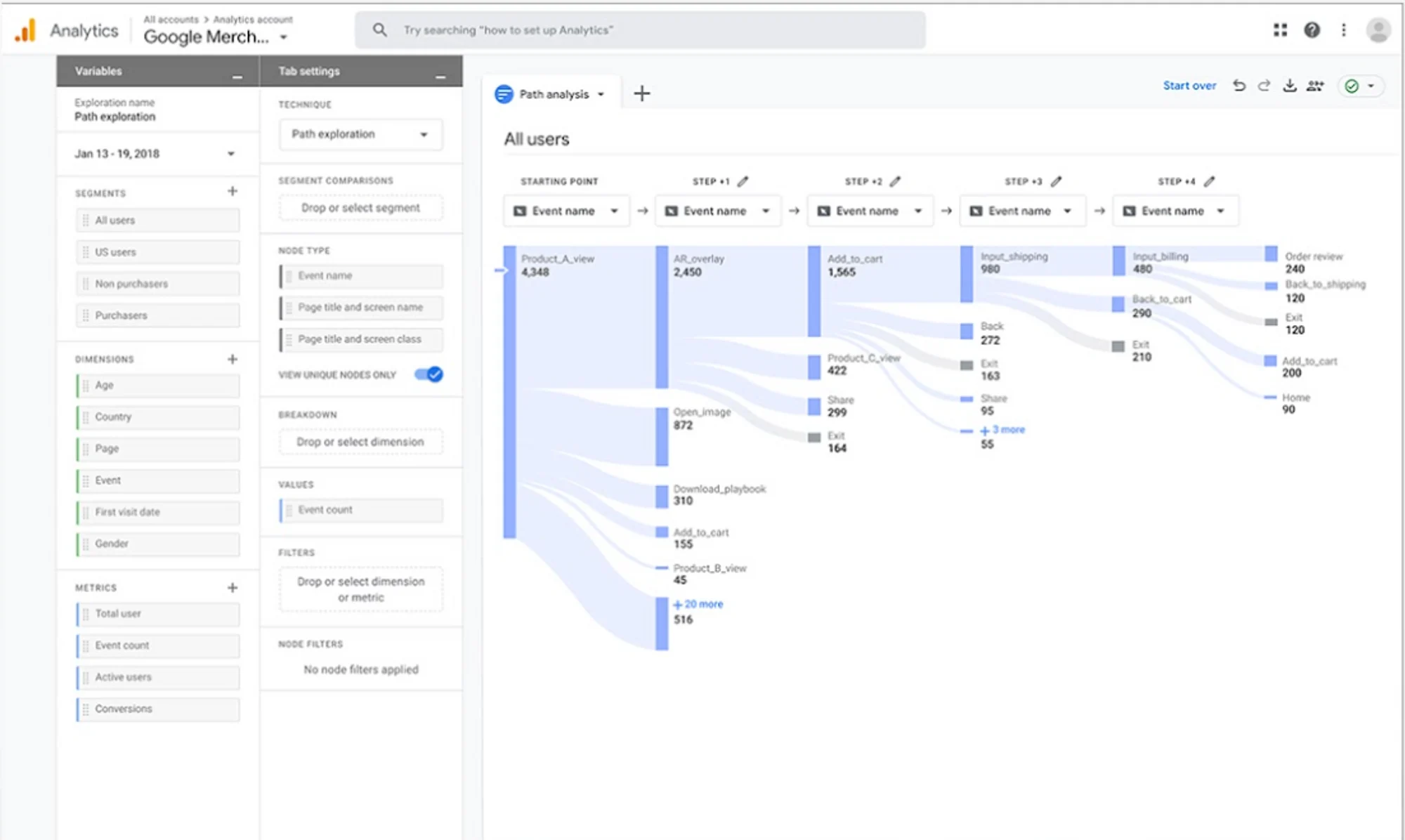
Kissmetrics
Kissmetric collects data from various web, mobile, email, and social media channels to provide a comprehensive overview of customer interactions. This can help companies better understand their customer journey mapping efforts and make changes accordingly.
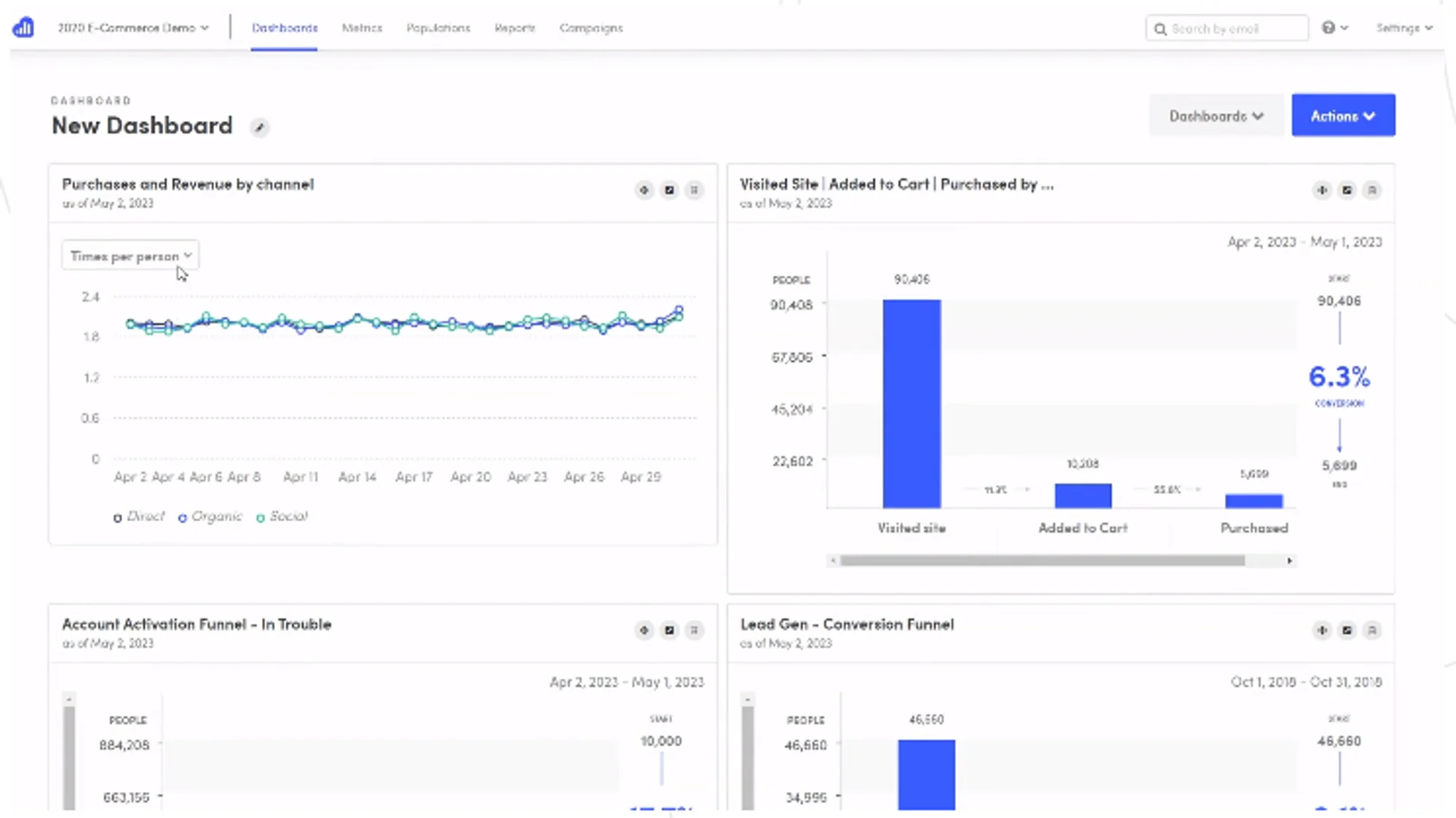
A tool that helps businesses monitor their brand's presence online. By tracking customer engagement across different channels, companies can get insights into how people interact with their brands and use this information to optimize the customer journey.
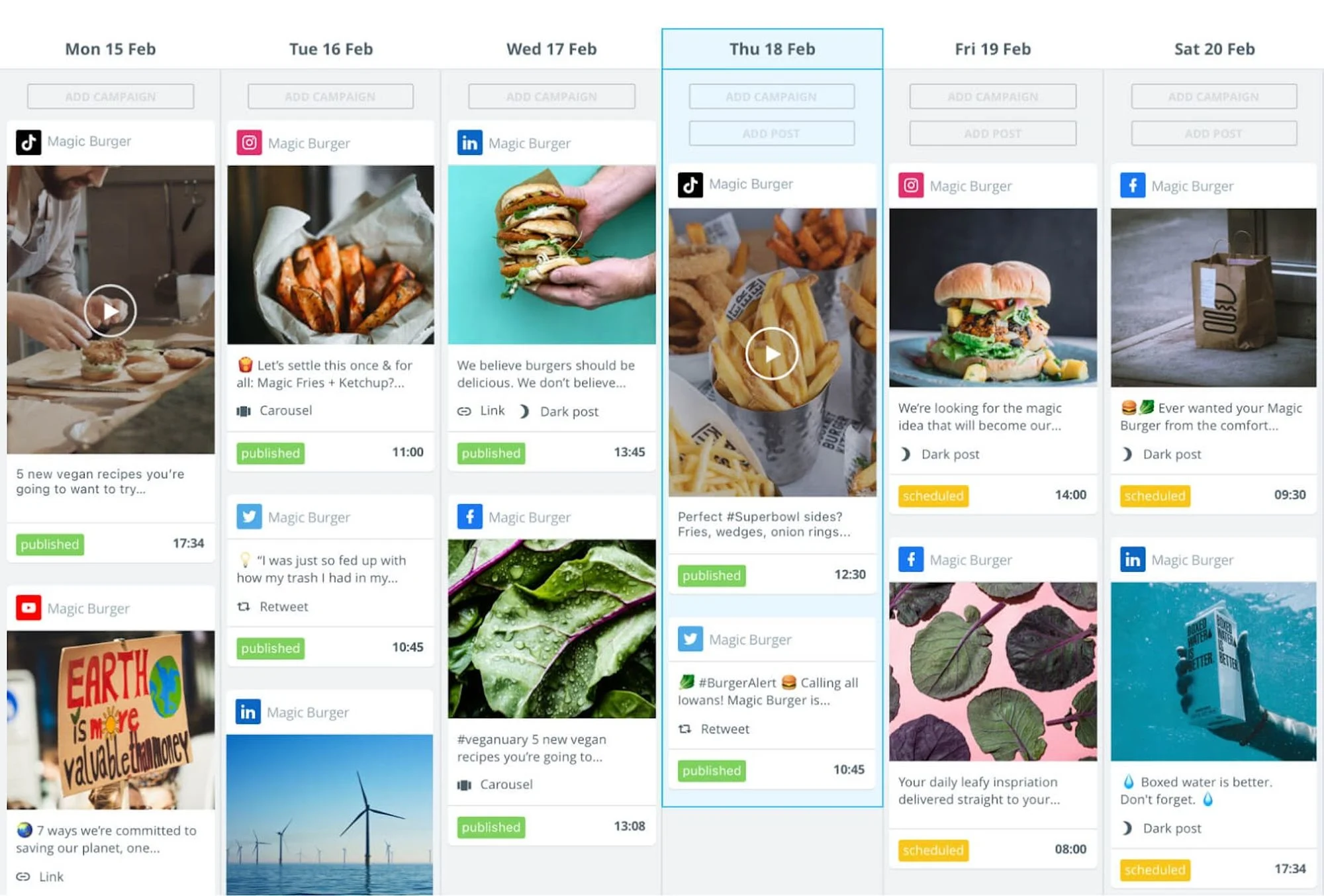
A social media management platform assisting companies in monitoring customer engagement on social media platforms. The tool provides detailed analytics of customer preferences and identifies areas for improvement in the omnichannel experience.
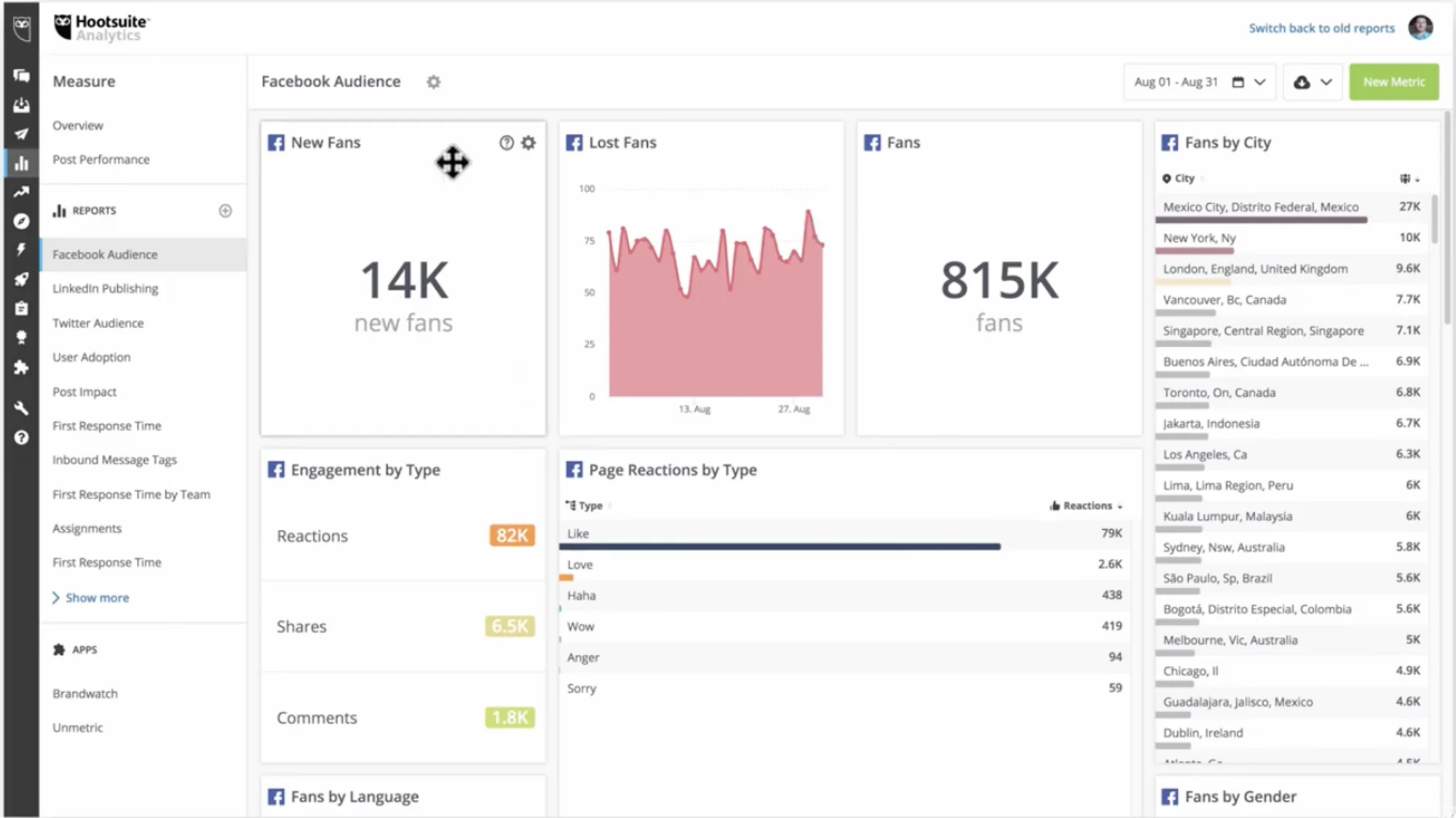
Optimal Workshop
Optimal Workshop is a comprehensive user research platform that allows companies to understand their customers' needs and behaviors through surveys, interviews, and usability testing. Companies can use this information to find opportunities for improvement in their customer journey mapping efforts and make changes accordingly.
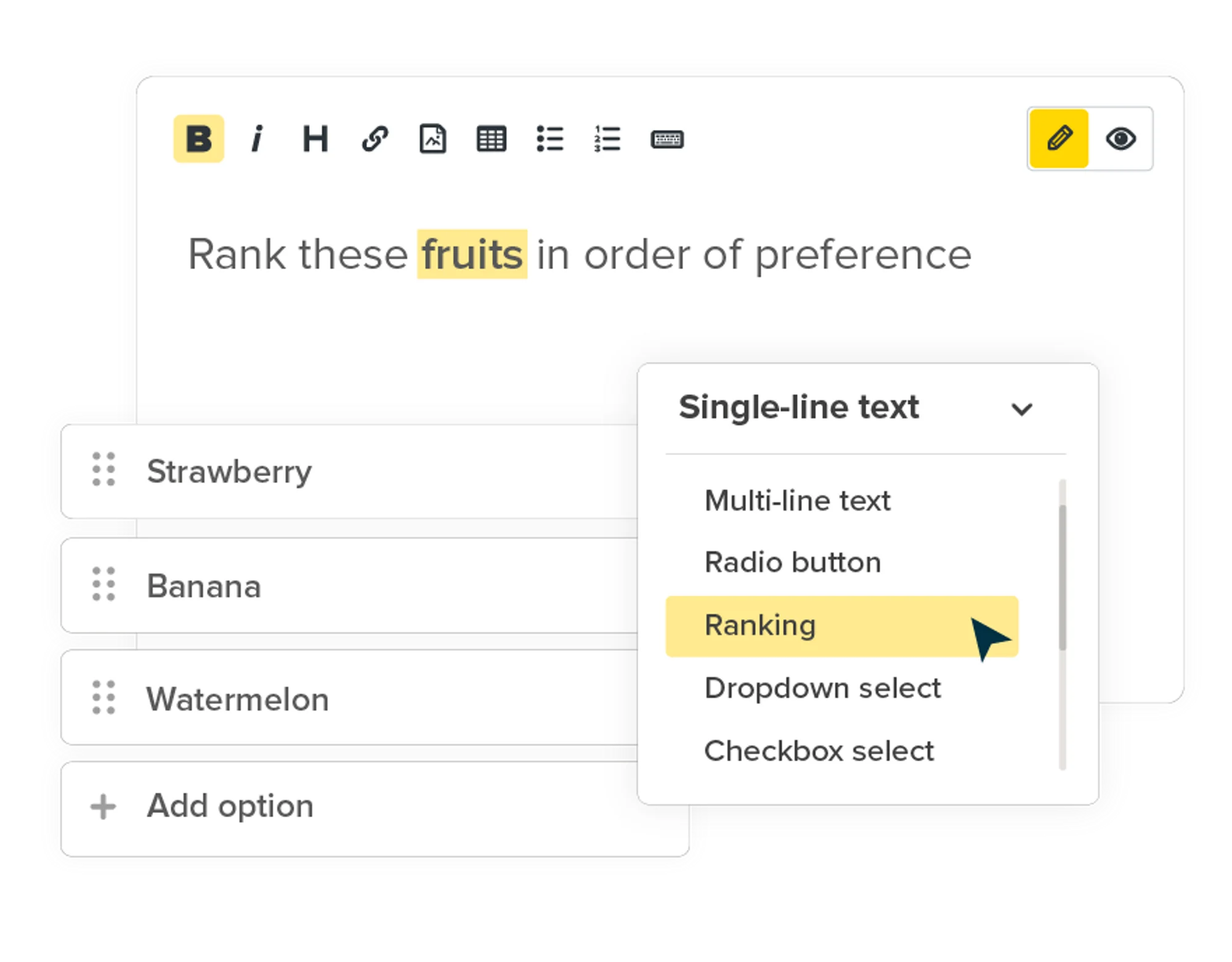
Zoho is a cloud-based platform designed to help businesses gain insights into their customer journey mapping efforts. The tool provides detailed analytics on user behavior, engagement, and conversions. This can help businesses identify areas for improvement in their customer journey and make changes accordingly.
Mind that there are many alternative tools with various capabilities and price ranges. Hence you can always find something suitable for your business.
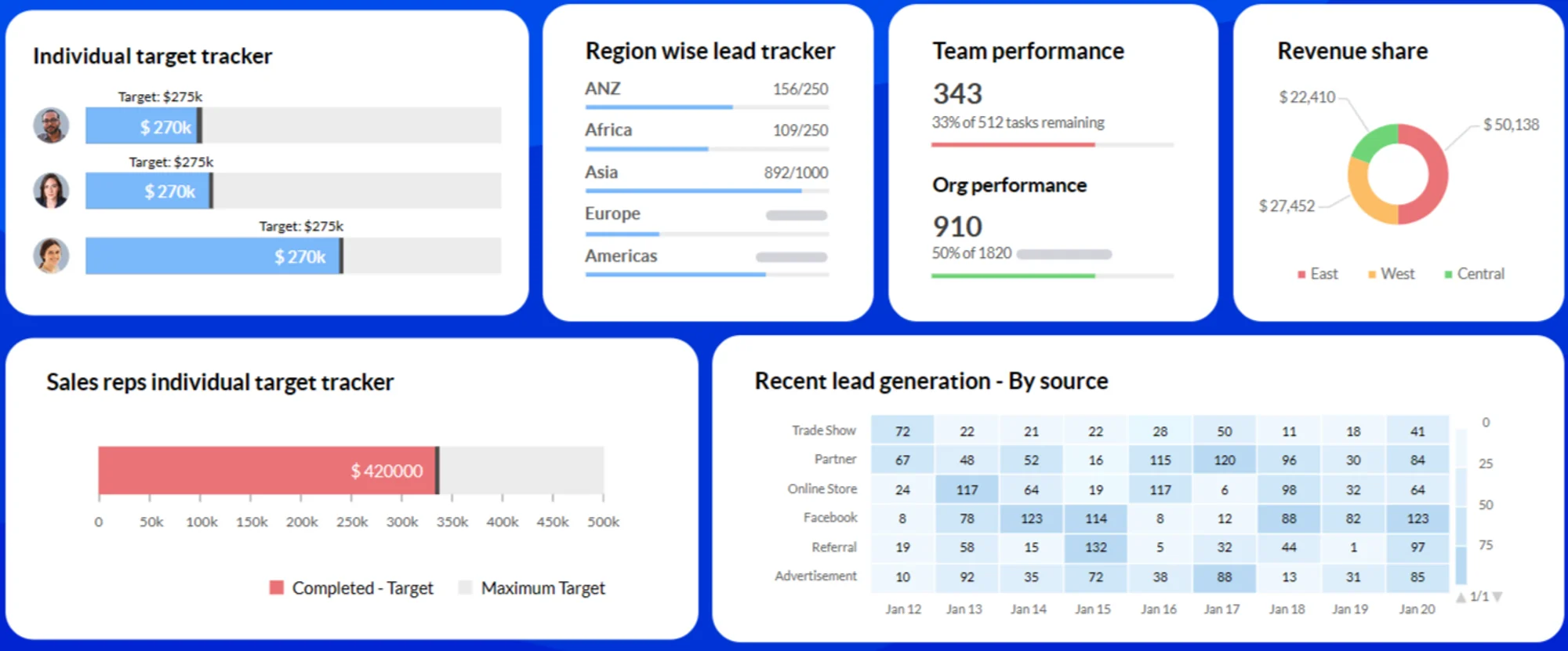
The Bottom Line
Omnichannel customer journey mapping can be a powerful tool for businesses looking to get an overall view of how their customers interact with their products or services across all channels.
By understanding customers' journeys better, companies can create experiences tailored toward each user and identify potential gaps in the current processes, all of which lead to increased brand loyalty over time. According to statistics , annual revenue growth for businesses with great omnichannel customer involvement is 9.5%, compared to 3.4% for businesses with poor omnichannel engagement. These numbers demonstrate the significant impact that omnichannel customer journey mapping can have on a business.
Although there may be some challenges associated with this process (automation issues, data collection/analysis, etc.), they can all be overcome by following the steps outlined above.
Frequently Asked Questions About Omnichannel Customer Journey Mapping
What is an omnichannel customer journey.
An Omnichannel Customer Journey is a multi-channel approach to marketing, selling, and serving customers in a way that creates an integrated and seamless customer experience. This journey encompasses all the different touchpoints a customer has with a brand, across multiple channels and platforms, such as online websites, physical stores, mobile apps, social media, and more. The primary goal of an omnichannel customer journey is to ensure a consistent and personalized experience for customers, regardless of how or where they choose to interact with the brand.
What Is Omnichannel Customer Journey Mapping?
Omnichannel Customer Journey Mapping is a strategic process of visualizing the path that a customer takes across multiple channels when interacting with a brand. This mapping process involves outlining all the consumer interactions and touchpoints with your brand, from the initial discovery to the final purchase and beyond.
What Does Omnichannel Marketing Mean for Customer Journey Mapping?
Omnichannel marketing and customer journey mapping go hand in hand. In the context of customer journey mapping, omnichannel marketing means creating a unified and seamless customer experience across all channels and touchpoints.
Learn how to deliver unique and personalized customer experiences to increase conversions
Keep Reading on This Topic

In this blog post, we will explore nine of the most common personalization challenges and discuss how to overcome them.

In this post, we will discuss some of the best practices and tips for using website content personalization to delight your customers and enhance user experiences.
Customer Journey Mapping: How to Create Perfect Maps
Zuzanna Bocian
A customer interacts with your brand multiple times before making a purchase. More than 63% of customers expect brands to know and understand their needs ( source ). But still, sometimes customers don’t feel the brands fulfill their needs. So, how do you attract a new customer?
Creating a meaningful connection with your customers is crucial for long-term business growth; customer journey marketing can help you achieve this. For instance, a customer may sign up for your website after reading an article, browsing your products, and purchasing. All of these interactions collectively form the customer journey.
What is digital customer journey mapping? How do you utilize it for your business? Let’s explore.
What is a customer journey map?
A company’s journey refers to a customer’s entire process when interacting with a brand, from initial awareness to purchase decisions. It encompasses all the touchpoints and experiences that a customer encounters along the way. Understanding the journey is crucial for businesses. Why?
It allows you to identify opportunities for improvement, optimize interactions, and ultimately enhance customer satisfaction and loyalty. It also plays a significant role in customer retention strategies.

Throughout these customer journey stages, customers interact with various touchpoints, which are the contact points between the customer and the company. Touchpoints can include a company’s website, social media profiles, customer service interactions, and more.
Optimizing these touchpoints at each journey stage is essential to provide a seamless and satisfying customer experience.
The benefits of customer journey maps
Improved customer satisfaction.
You can identify pain points and areas for improvement by understanding the user journey’s various customer touchpoints and stages. Addressing these issues and providing solutions can lead to a smoother and more satisfying customer experience, ultimately enhancing overall satisfaction.
For example, a retail company maps its customer journey for online purchases. Through journey mapping, they identify that many buyers abandon their carts during checkout due to complicated forms and a lack of guest checkout options.
In response, the company simplifies the checkout process, adds a guest checkout option, and includes progress indicators to guide customers through each step. As a result, customer satisfaction improves, leading to higher completion rates for online purchases.
Take care of your customers better with a unique ticketing system. ✅ Join the HelpDesk trial and try all its features. 🚀
Higher conversion rates
A customer journey map is a helpful tool that identifies crucial moments in the customer journey where potential shoppers are most likely to make purchasing decisions. You can increase the likelihood of converting leads into customers by optimizing these touchpoints and providing relevant information or incentives.
For instance, a software-as-a-service (SaaS) company can map the customer journey from trial sign-up to subscription. During this process, they may discover that many trial users drop off after the initial sign-up because they need clarification about how to get started. However, the company can improve user engagement and conversion rates from trial to paid subscription by providing personalized onboarding emails, tutorial videos, and live chat support during the trial period.
More effective marketing strategies
Nowadays, you must do more than just run ads to attract customers. The competition is very high. Mapping the customer journey provides insights into the customer’s mindset, preferences, and behaviors at each stage. With this knowledge, you can tailor their marketing strategies and messaging to better resonate with their target audience.
Consider an ecommerce company that plans to launch a new product. To ensure its success, they analyze the customer journey from the initial stage of product awareness to the final stage of purchase. They closely monitor customer behavior at each stage and identify the marketing channels and messages that resonate most with their target audience.
Based on this valuable insight, they tailor their marketing campaigns to better connect with their customers and increase the chances of a successful product launch.
Get a deeper understanding of customer needs
Customer journey mapping is a process that allows you to understand your customers’ journey by stepping into their shoes and seeing things from their perspective. This understanding helps uncover unmet needs, preferences, and pain points that may have gone unnoticed. By aligning products, services, and processes with customer needs, you can better meet and exceed customer expectations.
Identification of opportunities for innovation enhances the customer experience
How do you know which part of the product needs improvement? You can identify opportunities for innovation and differentiation through a customer’s journey map. You may discover new ways to enhance the customer experience, introduce new products or services, or differentiate themselves from competitors.
Essential elements of an effective customer journey map customer
A practical customer journey map comprises several crucial elements that provide valuable insights into the user’s perspective.
Customer personas
Customer personas represent fictional characters that embody the different segments of a business’s target audience. Each buyer persona typically includes demographic information, preferences, goals, and issues. Creating a detailed buyer persona allows you to empathize with their customers and tailor the customer journey map to specific audience segments. But to do that, you need to master customer communication.
Use HelpDesk to make things easier for you. Enhance your customer experience with a robust ticketing system. 🦸
Touchpoints
Touchpoints are customers’ interactions with the brand across different channels and platforms. These interactions can occur online (website, social media, email, etc.) or offline (in-store, customer service hotline, etc.).
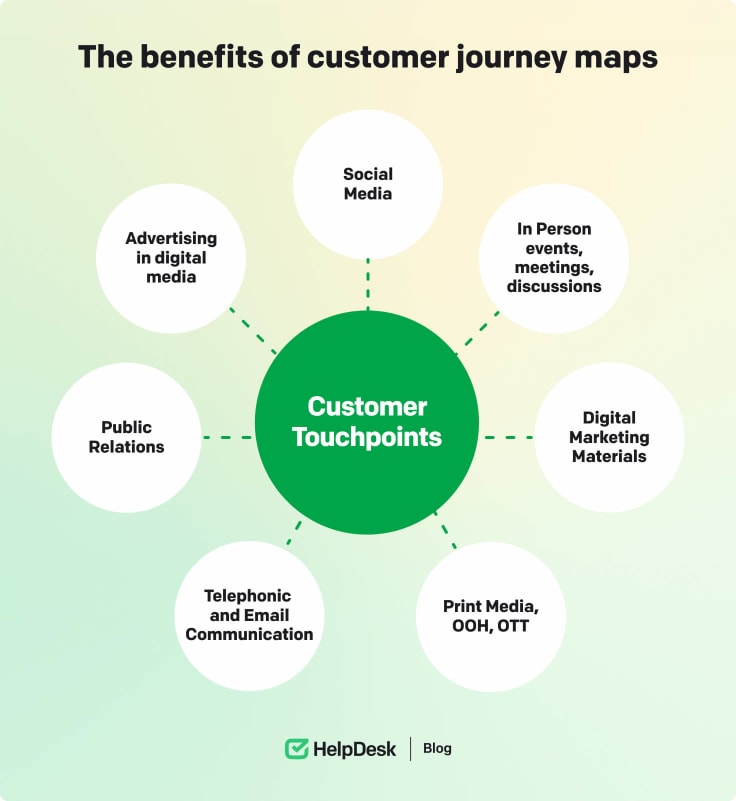
Channels are the various mediums or platforms that customers use to interact with a brand. These can be online channels like websites, mobile apps, social media, and email or offline channels like physical stores, events, and customer service centers. Understanding customers’ different channels can help optimize the omnichannel strategy and deliver a seamless experience across all touchpoints.
Emotions play a significant role in shaping a customer’s marketing experience and can influence their purchasing decisions. When creating customer journey maps, it’s important to consider customers’ emotions at each stage, such as excitement, frustration, satisfaction, or disappointment.
To better understand these emotions, you can use sentiment analysis techniques. Analyzing customer feedback, reviews, and social media mentions using natural language processing (NLP) tools can identify and categorize emotional cues in customer interactions.
Pain points
Pain points are customers’ obstacles, challenges, or frustrations with the brand. These can include long wait times, confusing website navigation, product defects, or poor customer service. Improving customer experience and increasing satisfaction and loyalty requires identifying and addressing these difficulties.

Steps to create your customer journey map
Creating a customer journey map is a strategic process that requires careful research. You can use different customer mapping templates to gain valuable insights into their customer journey stage and identify opportunities for improvement by following structured steps.
Here’s a comprehensive guide to creating your customer journey map:
Step 1. Research and data collection: Gathering qualitative customer data is essential. You can use surveys, interviews, and analytics.
Step 2. Persona development: To create effective customer personas, it is important to include demographic information, goals, challenges, preferences, and key attributes for each persona.
Step 3. Identification of touchpoints and channels: List all possible touchpoints and channels that customers may interact with during their journey with your brand.
Step 4. Mapping the customer’s emotional journey: Understand and document the emotional highs and lows that customers experience.
Step 5. Identifying moments of truth: Pinpoint critical decision-making points or “moments of truth” in the customer journey.
Step 6. Customer action planning: Use the insights data to develop action plans to improve customer experience. Identify strategic interventions and initiatives that address pain points and enhance touchpoints.
Step 7. Prioritize improvements: Based on your analysis, prioritize improvements that will significantly impact the customer experience and align with your business objectives. Consider factors such as feasibility, impact, and resource requirements.
Step 8. Develop solutions: Brainstorm and develop solutions to address the identified pain points and capitalize on opportunities.
Step 9. Implement changes: Implement the proposed changes to the customer journey, whether updating website content, training customer support staff, or redesigning product packaging. Because not all customer journeys are the same, ensure all stakeholders are aligned and committed to the implementation plan.
Customer journey marketing strategies and ideas
Create proper awareness for your product or service .
Potential customers learn about a product, service, or brand during the awareness stage. They may see it through advertising, social media, word-of-mouth recommendations, or online searches.
To attract customers, create blog posts, videos, or social media content that addresses common pain points or questions in your industry. Provide valuable insights and solutions without promoting your products directly.
When introducing your brand through marketing efforts, send introductory emails and provide educational content to spark interest and encourage further exploration. Some educational content can be a game-changer for you.
Customer decision-making
In this stage, customers decide to purchase the product or service. This buying process could involve weighing price, features, quality, and brand reputation. They may also evaluate factors like shipping options, return policies, or customer support.
Use journey stage-specific retargeting strategies to re-engage customers who have shown interest but have yet to convert. Serve personalized ads highlighting specific products or promotions they’ve previously viewed. The content for this stage includes:
Free demos of your product.
Free sign-ups.
Product promotions (for example, sign up and get 30% off).
Delivery details and facilities.
Purchase stage
After becoming aware of the product or service, customers consider whether it meets their needs or solves their problems. They might research more information, compare it with alternatives, read reviews, or seek recommendations from friends or online communities.
Develop comparison guides, case studies, or product demonstrations that help customers evaluate your offerings against competitors.
Highlight key features and benefits to showcase your value proposition.
Send targeted emails with testimonials, reviews, or success stories to build trust and credibility.
Provide in-depth information about your products/services to help customers make informed decisions.
Promote it through different channels (search engines, social media, website, etc.) to get new customers.
Now, customers are deciding whether to purchase the product or not. This could involve weighing price, features, quality, and brand reputation. They may also evaluate factors like shipping options, return policies, or customer support.
You can use journey stage-specific retargeting strategies to re-engage customers who have shown interest but have yet to convert or serve personalized ads highlighting specific products or promotions they’ve previously viewed.
Customer retention
This is when the customer completes the transaction and acquires the product or service. Depending on the business, it could happen online, in-store, or through other channels. You have to provide top-notch services so they’ll return to you rather than go for another provider.
You can leverage customer data to provide personalized shopping experiences, product recommendations, and customer service. Use past purchase history and preferences to tailor communications and offers.
Then, mechanisms for collecting customer feedback at various stages should be incorporated to continuously refine and personalize the buyer journey.
Provide a dedicated manager to make things easier for the customer.
Make your team accessible to the customers.
Create a knowledge base to solve common issues.
Learn more about customer retention in the latest Learning Space guide. 🧑🚀 Discover the best strategies to improve your user experience now. 🎉
Loyalty and advocacy
Design loyalty programs that reward customers for repeat purchases and encourage them to become brand advocates to identify loyal users. Offer exclusive perks, discounts, or rewards through customer messaging to incentivize ongoing engagement and referrals.
Integrating customer journey mapping into marketing strategies
Segment your audience.
It’s important to understand that each customer is unique, and their journey toward purchasing your product or service may differ from one another. To cater to these differences, you should segment your audience based on demographics, behavior, and preferences. Doing so allows you to create personalized marketing strategies that resonate with customer segments at various stages of their journey. Conducting proper user research can significantly impact the success of your business.
Align content with each stage of the journey
Develop marketing content that caters to customers at each stage of the journey.
For example, create engaging content to raise awareness, informative content to aid the consideration stage, persuasive content to drive decision-making, and helpful content to encourage customer loyalty and advocacy.
Optimize channel mix
Analyze which channels are most effective at different stages of the customer journey.
For instance, social media might be great for raising awareness, while email marketing customer journeys might be more effective for nurturing leads. Allocate your marketing customer journey budget and resources accordingly to optimize channel performance. It would be best if you made a proper service blueprint.
Implement feedback loops
Continuously gather customer feedback at each touchpoint to understand their experiences and pain points. Use this feedback to refine your marketing strategies and improve the customer journey.
Monitor and analyze key metrics
Track key performance indicators (KPIs) such as conversion rates, engagement metrics, customer satisfaction scores, etc., to gauge the effectiveness of your marketing efforts across different channels. Use this data to iterate and optimize your strategies over time.
Stay agile and iterative
The customer journey is dynamic, so your marketing strategies should be different. Stay agile and be prepared to adapt your tactics based on evolving customer behavior, user research, market trends, and competitive landscape.
Challenges and solutions in customer journey mapping
Getting stuck from the inside-out perspective of the customer journey.
Businesses often create journey maps based solely on their internal processes and assumptions rather than the actual experiences of their customers.
Solution: To overcome this challenge, you should adopt an outside-in approach by gathering customer insights through surveys, real-life examples, interviews, and feedback mechanisms. It ensures that the journey map accurately reflects the customer’s perspective and identifies pain points and opportunities for improvement. Make a proper visual representation for better understanding.
Taking too narrow a view of the customer journey
Focusing on more than just specific touchpoints or channels within the customer journey can result in an incomplete understanding of the overall experience.
Solution: Take a holistic view of the customer journey, encompassing all stages, touchpoints, and channels. It can help you identify interactions and dependencies across various touchpoints, enabling them to deliver a seamless and consistent experience across the entire journey.
Overlooking all the participants in the customer journey
Businesses often concentrate solely on the customer’s interaction with their own company. They often need to pay more attention to the involvement of other stakeholders or influencers who may impact the customer’s experience.
Solution: Expand the scope of the journey map to include all relevant participants, such as influencers, partners, and third-party service providers. Consider how each participant contributes to or influences the customer’s experience at different journey stages. This comprehensive approach helps businesses identify collaboration opportunities and potential areas for partnership to enhance the overall positive customer experience.
Lack of data or data overload
A massive amount of data is needed to create accurate and actionable journey maps. Without this data, it’s difficult to target customers and create a marketing funnel.
Solution: Balance qualitative and quantitative data sources to understand the customer journey comprehensively. Use customer feedback, customer journey analytics, journey mapping tools, and other relevant data sources to uncover insights about customer behaviors, preferences, and obstacles. Focus on collecting data pertinent to the specific goals of the journey mapping exercise and prioritize quality over quantity.
Failure to iterate and update journey maps
Customer journeys are dynamic and evolve due to changes in customer behavior, market trends, and business strategies. Failing to update regularly and iterate journey maps can lead to outdated insights and missed opportunities for improvement.
Solution: Treat the entire customer journey as an ongoing rather than a one-time activity. Monitor customer feedback, analyze performance metrics, and incorporate new insights to refine and update journey maps regularly. Establish a feedback loop to capture changes in customer needs and expectations, ensuring that journey maps remain relevant and actionable.

Customer journey mapping is a precious tool for businesses looking to connect with their customers. With today’s fierce competition, using a well-crafted customer journey map template is more important than ever. By thoughtfully analyzing and planning, organizations can pinpoint areas for improvement and elevate customer satisfaction.
Creating a solid customer map is the key to unlocking increased sales and achieving your business goals. With enthusiasm and optimism, we encourage you to explore the benefits of customer mapping and take your customer experiences to the next level.
Share it with the world
- copy-button#copy track#send" data-controller="track" data-track-category="HelpDesk Blog" data-track-action="Share" data-track-label="Copy link" > Copy link Link copied to clipboard https://www.helpdesk.com/blog/customer-journey-mappping/
Keep all communication in one place
Free 14-day trial Simple setup
You'll be in good company
Discover our track#send">text| products
LiveChat Connect with customers
ChatBot Automate customer service with AI
KnowledgeBase Guide and educate customers
OpenWidget Enhance websites with widgets
B2B Customer Experience
- Customer Experience Consulting
- Net Promoter Score® Consulting
- Net Promoter Score® Software
- Customer Feedback Consulting
- B2B Marketing
- B2B Marketing Services
- B2B Lead Generation
- B2B Content Marketing
- B2B Marketing Automation
- Case Studies
- Downloads and Tools
- Our Customers
- Our Company
The Benefits and Disadvantages of Customer Journey Mapping
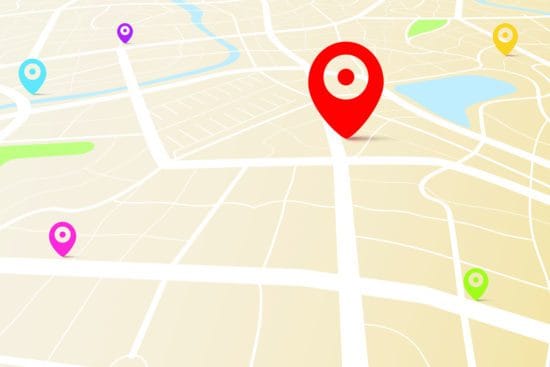
Customer journey mapping is a process to visualise and understand customer’s experience with a company. It involves identifying customer’s needs and emotions at each stage of the customer’s interaction with the company. The goal of customer journey mapping is to reduce customer effort, increase customer loyalty, and identify improvements in the customer experience.
Although customer journey mapping can be extremely beneficial, there are also some potential drawbacks that should be considered.
In this post we review both the advantages and disadvantages of using customer journey mapping in your business.
Improved Customer Acquisition
Enhanced ability to anticipate customer needs.

Advantages of Customer Journey Mapping
Increased customer value.
As with any task a company undertakes it must, in the end, generate business value. Creating a journey map is a cost to the business but it enables the organisation to increase company value in several ways.
Improved Customer Retention
Companies use journey maps to improve the customer experience and loyalty
Lower Costs
Often an improvement in an aspect of the journey or customer experience has the side benefit of lowering costs. For example at SmartGroup improved staff training that helped customers also lower staff turnover and recruitments costs.
Again improvements in the customer experience can lift acquisition rates, resulting in faster growth.
Improved Internal Communications
Perhaps the most tangible benefit of customer journey maps is their ability to clearly communicate the customer experience within the organisation.

The very process of creating a journey map forces people within the organisation to clarify and agree on what the customer experience is and how the organisation delivers that experience. That clarification includes consistent definitions of what happens in each part of the process.
In our Customer Journey Mapping workshops I often hear participants exclaim they “didn’t know that’s what happened in that part of the business.”
The map communicates what is expected and performed by each of the teams and systems in the organisation allowing clear and consistent communication: it is effectively another team communication app that help drive cross functional communication.
Forces Cross Functional Communication / Reduces Silos
Because the map takes the perspective of the customer not the organisation, people from all parts of the organisation must come together to build and maintain the journey map. This shared purpose drives meaningful interactions between groups and teams that may not normally do so.
In this way it often becomes an important element of the cultural change process needed for successful customer experience programs.
Identifies Customer Pain Points That Reduce Customer Loyalty
Having documented the customer experience journey, pain points for the customer and organisation become obvious.
Process gaps, opportunities for mis-communication and other customer annoyances are easier to see when the customer journey is mapped from end to end. This is information can be directly used to drive business improvement projects.
Identifies Cost Reduction Opportunities
It’s not often discussed but improvements in the customer journey can deliver substantial reductions in organisational cost.
Manheim reduced calls to their service desk by 30+% with a simple change in their post-order processes which was uncovered through analysis of customer input to their customer journey.
Again by clearly documenting what is happening problems and opportunities become easy to see.
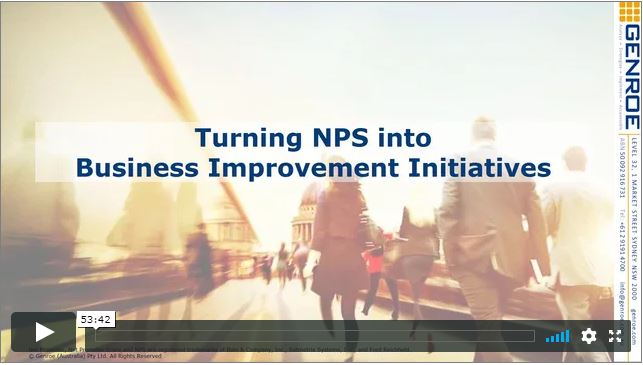
Customer journey mapping can help your team anticipate customer needs, enabling you to be proactive in responding to customer requests.
Disadvantage of with Customer Journey Maps
That is not to say that customer journey maps are perfect. Here are some disadvantages to customer journey maps.
Journey Maps Need to Be Acted Upon.
This is not so much a problem with Journey Maps as with driving change in any organisation. Creating the map itself does not create any change or improvement for the organisation, it is just a step in the process.
In order to see the full value of the map the organisations needs to use it to identify and implement opportunities for improvement.
Require Cross Functional Support
No one group within the organisation can create and maintain the customer journey map. It requires the active support of all areas.
If your organisation is very resistant to working across business silos or groups it might be difficult to create an accurate map of the customer journey.
On the other hand of course, the very act of creating the map will help break down those silos.
They Can Become Another Hidden Document
If, like so many other strategic documents, the map becomes something hidden in a drawer and not used day to day, its ability to be a core communication document will be lost.
When selecting your customer journey mapping software ensure that it has the ability to provide shared access and updates so the map “lives” in the organisation.
You Might Need Multiple Maps for Different Personas
Where their journey’s differ, a good customer journey map is centred around a specific customer persona or personas. This means that you might need to create more than one map to cater for those different personas.
But be cautious, just because you have different personas does not necessarily mean you need different maps. If the journeys customers undertake are the same or very similar, you do not need to create a unique map for each.
Customer’s Don’t Always Follow the Map
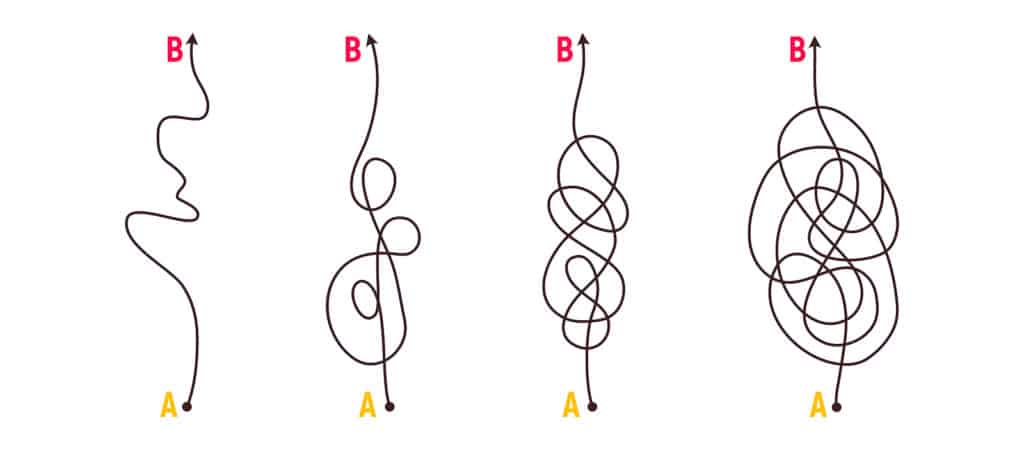
It would be nice if every customer consistently followed the map you uncover, however complex, but that’s not the reality.
Customers will often skip steps, loop back and re-do steps, etc.
As technology evolves and, especially, as the buyer journey the becomes more fragmented customers will more often take detours through your map.
Again this doesn’t mean the map is not useful, just that you need to adjust your expectations of how “perfectly” it matches every customer’s experience.
Potential for Data Overload
With modern computer and telephony systems it’s easy to collect and store data. The problem is just becuase you can collect a piece of data doesn’t mean it’s important in the customer journy.
And if unimportant data is collected and analysed, it can be difficult to draw meaningful conclusions and make decisions.
It’s important that you don’t collect any and all data, just in case it’s important.
Instead you should at least have a hypothesis as to how each piece of data might be important to the customer experience before you start collecting it.
- Customer Journey Mapping
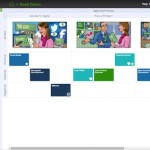
2024’s Best Customer Journey Mapping Tools

Customer Pain Points: What They Are and How to Solve Them
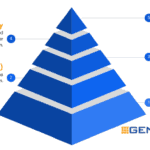
Understanding and Using the Marketing Customer Journey
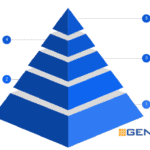
The 5 Stage Retail Customer Journey

Fixing Customer Pain Points Using Customer Journey Maps

How to Run a Customer Journey Mapping Workshop

Customer Journey Vs User Journey Vs Buyer Journey: Selecting the Right Type of CX Map

The Practical Guide to B2B Customer Journey Mapping

Buyer Personas: How to Create this Critical Business Asset
- CX Consulting
- NPS Consulting
- NPS Software
- Customer Feedback
- B2B Marketing Guide
- Customer Feedback Guides
- [email protected]
- +61 2 9191 4700
- Book a Meeting
- Level 33, 264 George St Sydney, NSW 2000
Copyright Genroe (Australia) Pty Ltd | All Rights Reserved. | Privacy Policy | Cookie Policy Net Promoter, Net Promoter Score and NPS are registered trademarks of Bain & Company, Inc., Satmetrix Systems, Inc., and Fred Reichheld.
Enhancing Customer Experience: The Power of Journey Maps
- August 12, 2023
- Customer , Customer experience , Customer satisfaction , Loyalty business model , Marketing , Organization , Personalization , Understanding

Do you want to enhance your customer experience and drive customer satisfaction? Discover the power of journey maps. These visual representations of your customers’ interactions with your brand identify pain points and opportunities for improvement. By mapping out touchpoints, interactions, and emotions, you gain a holistic view of the customer journey. With this insight, you can align your efforts, meet customer needs and expectations, and design personalized experiences. Experience increased customer satisfaction and loyalty through the strategic use of journey maps.
Table of Contents
Key Takeaways
- Customer journey maps help improve customer experience
- They provide a visual representation of the customer experience
- Customer journey maps help identify pain points and opportunities for improvement
- Customer journey maps enable a better understanding of customer needs and expectations
The Benefits of Customer Journey Maps
Customer journey maps help you improve customer experience by providing a visual representation of the steps customers go through and identifying pain points and opportunities for improvement. These maps are instrumental in measuring the effectiveness of your customer journey and implementing changes to enhance it. By mapping out the customer journey, you can easily identify areas where customers may encounter difficulties or frustrations. This allows you to make targeted improvements to those specific touchpoints, resulting in a smoother and more satisfying experience for your customers. Additionally, customer journey maps help you prioritize areas for improvement by highlighting the most critical pain points. By implementing changes based on these maps, you can ensure that your customer experience is consistently meeting and exceeding customer expectations.
Mapping the Customer Experience
Start by exploring and visualizing the steps you take as a consumer to better understand your own experience. Customer journey mapping techniques are valuable tools for measuring customer experience effectiveness. These maps illustrate the steps customers go through, providing a visual representation of their experience. By mapping out the touchpoints and interactions at each stage, you can identify pain points and opportunities for improvement. Customer journey maps help align the organization’s efforts and enable a better understanding of customer needs and expectations. They also facilitate the design of personalized and targeted experiences. By validating the customer journey map with customer feedback and testing, you can ensure its accuracy. These maps inform strategic decision-making and guide the development of customer-centric initiatives. Regularly updating and refining customer journey maps based on feedback and changes in customer behavior will lead to increased customer satisfaction and loyalty.
Identifying Pain Points and Opportunities
Identifying pain points and opportunities is crucial for improving your understanding of the customer journey and driving action towards a more satisfying experience. By identifying customer pain points, you can uncover growth opportunities that can lead to significant improvements in your business. When you identify customer pain points, you are able to pinpoint areas where customers are experiencing difficulties or frustrations. This allows you to take action and make changes that will address these pain points and provide a better experience for your customers. Additionally, by uncovering growth opportunities, you can identify areas where you can expand your business and attract new customers. By focusing on both pain points and growth opportunities, you can enhance the overall customer experience and drive business success.
Aligning Efforts for Customer Success
To align efforts for your success, ensure that all departments and teams are working together towards a common goal. This alignment is crucial in measuring the effectiveness of your customer journey maps and enhancing the overall customer experience. By aligning teams, you can ensure that everyone is on the same page and working towards a shared objective. This collaboration allows for better coordination and communication, leading to more efficient and effective initiatives. It also enables you to measure the effectiveness of your customer journey maps by analyzing the results and feedback from various departments. By aligning efforts and measuring effectiveness, you can continuously improve your customer experience and drive better outcomes for your organization.
Understanding Customer Needs and Expectations
Understand what your customers want and expect from your organization to effectively meet their needs and deliver a satisfying experience. To achieve this, it is crucial to conduct customer feedback analysis and ensure that you are meeting customer expectations. Here are some key points to consider:
- Regularly analyze customer feedback to gain insights into their preferences and pain points.
- Use the feedback to identify areas where you can improve and enhance the customer experience.
- Ensure that your products and services align with customer expectations to build trust and loyalty.
- Continuously monitor and adjust your strategies to meet evolving customer needs.
- Implement personalized and targeted experiences to create a positive and memorable customer journey.
Prioritizing Improvement Areas
Now that you have a clear understanding of your customers’ needs and expectations, the next step is to prioritize the areas that need improvement in their journey. Measuring the effectiveness of the customer journey is crucial in identifying these areas. By using customer journey maps, you can visualize the steps customers go through and pinpoint pain points and opportunities for enhancement. To ensure accurate mapping, it is important to follow customer journey mapping best practices. This includes defining customer personas or segments, gathering data on customer behavior, identifying the different stages of the journey, and mapping out touchpoints and interactions. Validating the journey map with customer feedback and testing is also essential. By prioritizing improvement areas based on these maps, you can drive action and implement targeted initiatives to enhance the overall customer experience.
Designing Personalized Experiences
You can create personalized experiences for your customers by tailoring your interactions and touchpoints according to their specific needs and preferences. Personalization strategies are crucial in enhancing customer experience and building strong relationships. By understanding your customers’ preferences, you can design experiences that resonate with them on a deeper level. This can be achieved by collecting and analyzing customer data, such as their purchasing history, preferences, and feedback. By using this information, you can create tailored interactions that make customers feel valued and understood. Whether it’s through customized recommendations, personalized offers, or targeted messaging, creating memorable interactions can leave a lasting impression on your customers and increase their satisfaction and loyalty. Remember, the key to successful personalization is to continuously refine and adapt your strategies based on customer feedback and changing preferences.
Increasing Customer Satisfaction and Loyalty
To increase customer satisfaction and loyalty, focus on delivering personalized experiences that cater to their specific needs and preferences. By understanding your customers’ preferences and tailoring your offerings to meet their expectations, you can enhance their overall experience and increase customer retention. Improving customer loyalty is crucial for businesses as it leads to repeat purchases and positive word-of-mouth recommendations. Utilizing customer journey maps can help identify pain points and opportunities for improvement, allowing you to address specific areas that may be impacting customer satisfaction and loyalty. By mapping out the touchpoints and interactions throughout the customer journey, you can design targeted experiences that resonate with your customers and create a lasting impression. Regularly updating and refining these maps based on customer feedback and changes in behavior will ensure that you continue to meet and exceed their expectations, ultimately driving increased customer satisfaction and loyalty.
Elements of a Successful Journey Map
Map out the touchpoints and interactions throughout the customer journey to capture the emotions and motivations of your customers. Defining customer personas is essential in creating a successful journey map. By gathering customer insights, you can gain a deeper understanding of their behaviors and preferences. This allows you to create a more personalized and targeted experience for your customers. Customer journey maps help you identify the different stages of the customer journey and map out the touchpoints and interactions at each stage. They provide a visual representation of the customer experience, highlighting key decision points and moments of truth. By incorporating customer emotions and motivations into your journey map, you can create a more empathetic and impactful experience for your customers. Gathering customer insights and defining customer personas are crucial steps in creating a successful journey map.
Driving Action With Customer Journey Maps
Now that you understand the elements of a successful journey map, it’s time to take action. One way to drive action is by using customer journey maps for product development. By mapping out the customer journey, you can identify pain points and opportunities for improvement in your products or services. This allows you to make informed decisions and prioritize areas for enhancement. Additionally, journey maps can help you measure the effectiveness of your customer journey maps. By gathering customer feedback and testing, you can validate and refine your maps to ensure they accurately reflect the customer experience. Measuring the effectiveness of customer journey maps is crucial in understanding if your efforts are truly improving the customer experience and driving positive outcomes for your business.
Frequently Asked Questions
What are some common challenges in creating a customer journey map.
Some common challenges in creating a customer journey map include gathering accurate data, understanding customer emotions and motivations, and effectively mapping touchpoints. However, with effective strategies such as customer feedback and testing, these challenges can be overcome.
How Can Customer Journey Maps Be Used to Improve Internal Processes and Workflows?
To improve internal processes and workflows, use customer journey maps. Identify areas for improvement, streamline operations, and increase efficiency. By mapping out the customer journey, you can optimize your organization’s efforts and achieve better results.
Are There Any Limitations or Drawbacks to Using Customer Journey Maps?
Limitations and drawbacks of using customer journey maps include potential oversimplification, difficulty in capturing all customer journeys, and the need for ongoing updates. However, they can still provide valuable insights for improving customer experience.
How Can Customer Journey Maps Be Integrated With Other Customer Experience Management Tools?
Integrating customer journey maps with CRM systems can enhance your understanding of customer needs. Utilize these maps for product development, aligning departments, and implementing targeted marketing campaigns to improve the overall customer experience.
What Are Some Best Practices for Effectively Communicating and Sharing Customer Journey Maps Within an Organization?
To effectively communicate and share customer journey maps within your organization, prioritize effective collaboration and stakeholder engagement. Ensure that all relevant teams are involved and informed, fostering a shared understanding and commitment to improving the customer experience.
Create, publish and optimize pages with a drag&drop, pixel perfect and mobile-friendly builder
Speed up the creation process with 400+ customizable templates for landing pages, pop-ups and sections
Refine your messaging with AI-generated text, SEO and image edition. All in one app
Test and compare page variants for data-driven decisions and valuable insights on users interactions
Track microconversions in your Dashboard and analyze events and clicks with visual map
Integrate your pages with your favorite mar-tech apps and solutions to get the flow of your campaign going
Drive sales and conversions with irresistible product displays and seamless shopping experiences
Use a reliable and secure platform that smoothly handles millions of visits
Master digital marketing with the help from savvy professionals and increase your website’s conversions
Guides for beginners, set-up instructions and creation tips to get started and optimize your pages
A free online course for landing page creators! Learn the secrets of high-converting pages and become an expert
Get the answers you’re looking for – contact us
Schedule a one-on-one meeting with us and learn more about the benefits of our platform
- Portuguese (Brazil)
Omnichannel Customer Journey Mapping: The Ultimate Guide
Kate Parish

In today’s digital era, businesses need to ensure seamless customer experiences across all channels. Omnichannel customer journey mapping is a crucial tool for reaching this objective. Businesses may uncover pain areas, ensure better interactions, produce a consistent customer experience, decrease the abandoned shopping carts rate, and improve other KPIs by recognizing every touchpoint in the customer journey.
In this comprehensive guide, we’ll discuss the significance of omnichannel customer journey mapping and offer a step-by-step process for making one. We’ll provide you with the knowledge and skills business owners and marketing specialists require to improve the customer experience and raise satisfaction.
Make your sections smartable and let go of mundane manual tasks with Smart Sections! An easy way to manage bulk changes.
Omnichannel customer journey maps explained.
An omnichannel customer journey map visually depicts a customer’s interactions with a brand across all touchpoints, channels, and devices. It presents a comprehensive picture of the customer journey, taking into account both online and offline encounters and emphasizing the possibilities, challenges, and crucial moments that might have an influence on customer satisfaction .
Understanding your potential lead or customer will help you drop the rate of abandoned shopping carts and increase the number of valuable leads.
To create an efficient omnichannel customer journey map, businesses need to collect information on consumer interactions across all channels, including social media, websites, mobile applications, email, and in-store encounters. This data has to be thoroughly examined to identify recurring trends and patterns that can assist in extensive map creation.
The map should be done with the customer’s needs, preferences, and habits in mind. All the stages of the customer journey, from awareness to loyalty, should be considered, and important touchpoints that might affect the customer experience should be identified.
Once the map has been made, it may be utilized to pinpoint problem areas and establish plans for enhancing the client experience. Businesses may use the map, for instance, to identify the precise touchpoints where a client is having trouble making an online purchase and come up with ways to streamline the procedure.
Get 111 Landing Page Examples —The Ultimate Guide for FREE
Why should you adhere to a customer journey omnichannel model.
By offering a smooth and customized consumer experience across all channels, the omnichannel model may help companies stay competitive in today’s digital environment. Here are some further arguments in favor of using the omnichannel strategy.
- Improved customer experience: Businesses may offer a smooth customer experience across all channels, including social media, email, chat, phone, and in-store, by employing an omnichannel approach. This might raise loyalty and boost customer satisfaction.
- Better engagement: an omnichannel strategy allows organizations to interact with consumers at every touchpoint, resulting in increased possibilities for contact and the development of stronger relationships.
- Higher conversion rates: Companies may boost conversion rates and lower customer turnover by giving customers a unified, tailored experience across all channels.
- Better data insights: By using an omnichannel strategy, organizations may gather data from many sources and better understand the behavior, preferences, and pain points of their customers. This can enhance overall business performance and provide information for future marketing tactics.
- Enhanced operational effectiveness: By integrating data, procedures, and technology across all channels, an omnichannel strategy may assist companies in streamlining their operations and lowering costs.
Omnichannel Customer Journey Mapping Step-By-Step
Finding your major target customer categories and channels is generally the first step in the omnichannel customer journey mapping process. Determine the stages of the journey, which may include awareness, deliberation, purchase, post-purchase, and advocacy. Consider the exact areas you want to concentrate on and the precise results you wish to attain. This will keep you on task and help you maintain your attention. Other steps of the omnichannel journey mapping process are the following:
Identifying the Touchpoints and Micro-Conversions
Determine little actions that help website visitors achieve a bigger objective (like making a purchase). Micro-conversions are potent predictors of user engagement, purchase intent, and sales funnel performance, even if they often do not contribute to a website’s total conversion rate.
List all the touchpoints where customers may interact with your brand for each channel. Examples of touchpoints include a website visit, email opening, placing an order, getting a confirmation message, and other actions. Sort each touchpoint according to the phase of the customer journey it takes place in. For instance, a confirmation letter serves as a post-purchase touchpoint, whereas an email newsletter is an awareness touchpoint.
Then evaluate each touchpoint based on how well it satisfies the requirements and expectations of the consumer. Determine the shortcomings of the touchpoints and possibilities to enhance the customer experience.
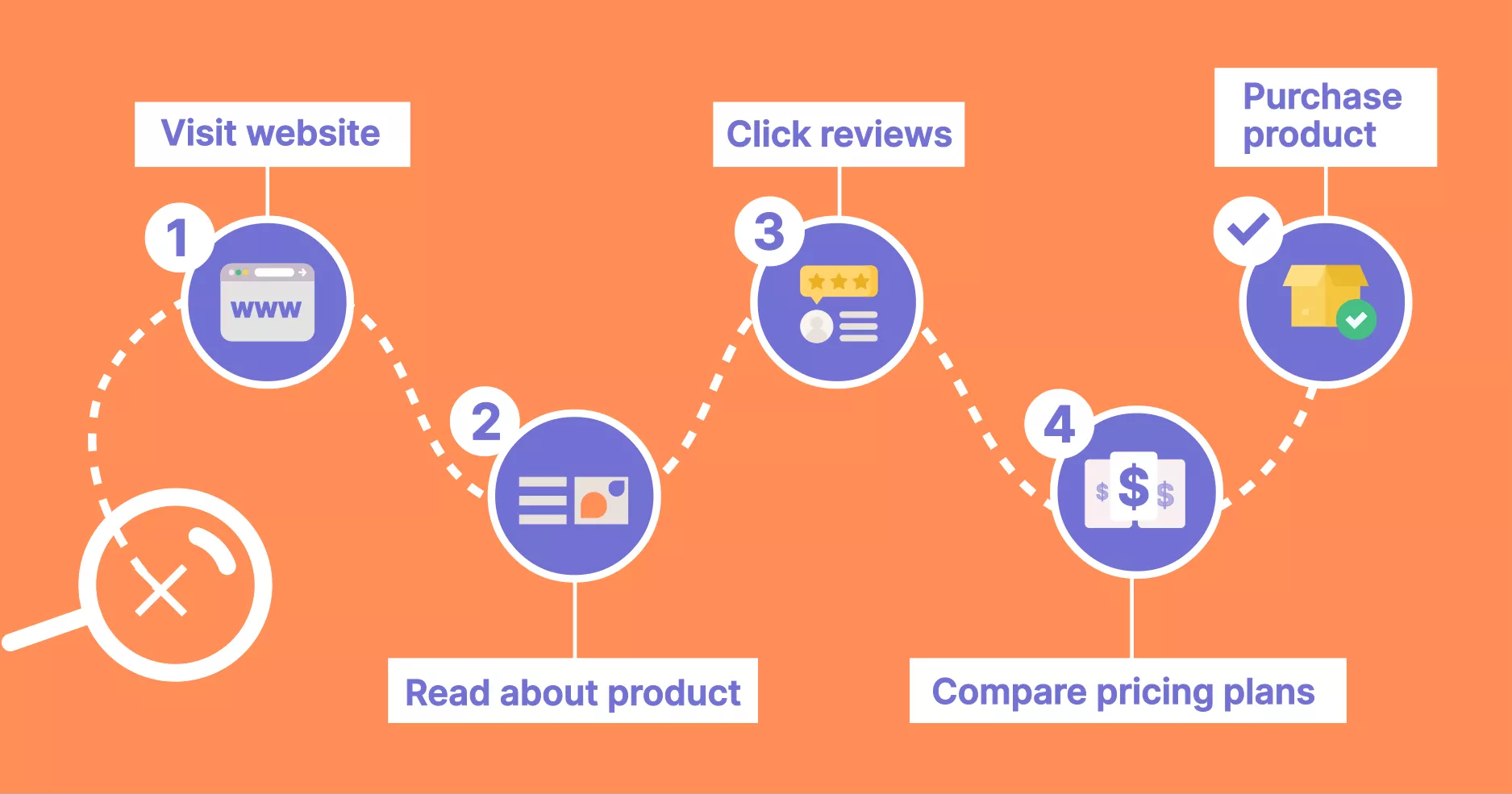
Gathering Customer Data
Gather information on consumer behavior and input from all online and offline touchpoints, including social media, email, phone, in-store, and chatbots. After gathering information from each touchpoint, arrange it in a way it is simple to interpret and visualize. Spreadsheets and customer journey mapping software are tools you may use to do this. Analyze the obtained data to find patterns, gaps, and pain points throughout the customer journey.
Creating Personas
Based on the data analysis, create customer personas that depict the various client base groups. Analyze the patterns in the information you have gathered. Group your consumers according to any shared traits they may have.
Once you have determined the traits that each group shares, make up fake customer profiles to represent each one. Give each persona a name, age, occupation, list of hobbies, and other pertinent details. Make the identities as specific as you can.
Use your established personas to guide your product development and marketing efforts. Ask yourself questions like “How would this persona react to this product?” “What channels would this persona use to find information?” or “What drives this persona to make a purchase?”
Focus on the user – before starting your campaign, ensure that the content reflects your potential clients’ needs.
Identifying Pain Points and Opportunities
Examine the customer journey map to find problems, obstacles, and areas that may be improved. Keep an eye out for points in the customer journey where your consumers are having trouble, running into roadblocks, or getting frustrated. The product characteristics, customer service, or delivery timeframes may be the source of these problems.
Look for opportunities to improve the customer experience. These possibilities can involve delivering tailored advice, enhancing communication, or providing further services.
Prioritize the discovered opportunities and pain points in accordance with how they will affect your company’s objectives and the client experience.
Implementing Changes and Monitoring Progress
You’ll need to create a plan to improve all the weak points, solve the problems customers face, and use all the opportunities. You can use a template action plan to get started if necessary. To ensure that your customer journey mapping and action plan stays applicable and efficient in achieving your company objectives, continually examine and update it.
Customer Journey Mapping Best Practices
Understanding the mapping process is crucial, but looking for additional solutions is still imperative to make the process easier and more efficient. Here are some valuable tips worth paying attention to.
Employ the Relevant Tools
Use digital technologies to streamline the omnichannel customer journey mapping process. Here are a few examples:
- Customer Journey Mapping Software: These products make planning out customer journeys simpler and more logical by offering drag-and-drop interfaces, pre-built templates, and other capabilities. Software for charting the customer journey includes Touchpoint Dashboard, Smaply, and CX Journey.
- Analytics Tools: Data regarding consumer behavior and interactions across many channels may be gathered using analytics tools. When utilized to identify pain points and potential improvement areas, these tools can offer insights into how customers interact with a company at various stages of their journey. Google Analytics, Mixpanel, and Kissmetrics are a few well-known analytics programs.
- CRM Systems: To keep track of client interactions across various channels and touchpoints, customer relationship management (CRM) systems are utilized. Such tools help personalize customer interactions by gathering data on consumer preferences, previous purchases, and other important data points. Among the popular CRM systems are Salesforce, HubSpot, and Zoho.
- Social media listening: Such technologies may be used to track what clients say about a company on social media platforms. Businesses may use this to pinpoint areas where their customer experience could be enhanced and respond instantly to consumer complaints and feedback. Sprout Social, Brandwatch, and Hootsuite are a few known social media listening apps.
- User testing: Utilizing testing technologies, businesses may learn from actual customers about their interactions with their goods and services. Surveys, focus groups, and other kinds of user testing might fall under this category. User testing may offer insightful information on how customers interact with a company through various channels and touchpoints. Optimal Workshop, UserTesting, and UsabilityHub are well-liked user-testing software programs.
Head to the Integration Catalog to browse in-app, compatible, and Zapier integrations with Landingi.
Integration and automation tools will optimize your workflow and make it easier to manage data from various sources in one place.
Always Ask for a Customer Feedback
Your decision-making process should be guided and informed by customer feedback if you want to innovate and make improvements to your product or service. It brings wonderful possibilities that can aid in enhancing the omnichannel consumer experience.
Providing customers with a simple option of leaving feedback is essential for exceptional customer service. Thanks to the omnichannel strategy, brands can interact with customers through any channel and get feedback at each point of contact. There are several ways to get client feedback, including through websites, social media, emails, in-app surveys, and reviews. The information obtained will help you keep your strategy flawless.
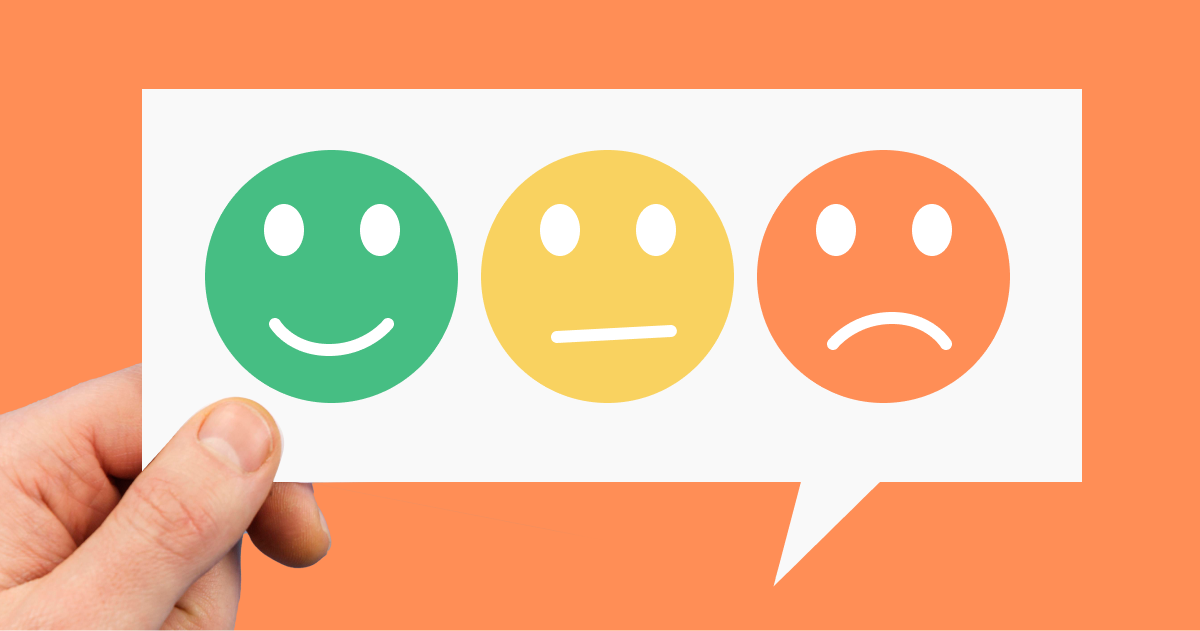
Offer Self Service
Providing customers with self-service choices is another lucrative strategy, capable of enhancing the whole brand experience. One of the most crucial aspects of the customer experience is reaction speed. Customers need prompt responses to their inquiries. Through self-service portals, they may instantly access information, which also helps businesses save time and resources. Businesses can provide how-to videos, manuals, and tutorials to assist consumers in resolving their issues on their own.
Finally, omnichannel customer journey mapping is crucial for companies to comprehend customers’ experiences across all touchpoints and enhance their journey. Businesses may uncover issues and opportunities for optimization and customize their marketing strategies by developing a comprehensive perspective of the customer’s interactions.
In contrast to organizations with weak omnichannel strategies, which only keep 33% of their customers , companies with effective omnichannel customer engagement strategies have an average of 89% client retention. These figures show what a big difference omnichannel customer journey mapping can make to a company’s bottom line.
Businesses may enhance customer experience, better understand consumer wants and preferences, and ultimately increase revenue by utilizing omnichannel customer journey mapping.
Ready to go? Let’s get started!
Join us and create the best-converting landing pages

Content Writer
Related articles

10 Best A/B Testing Tools For Conversion Optimization
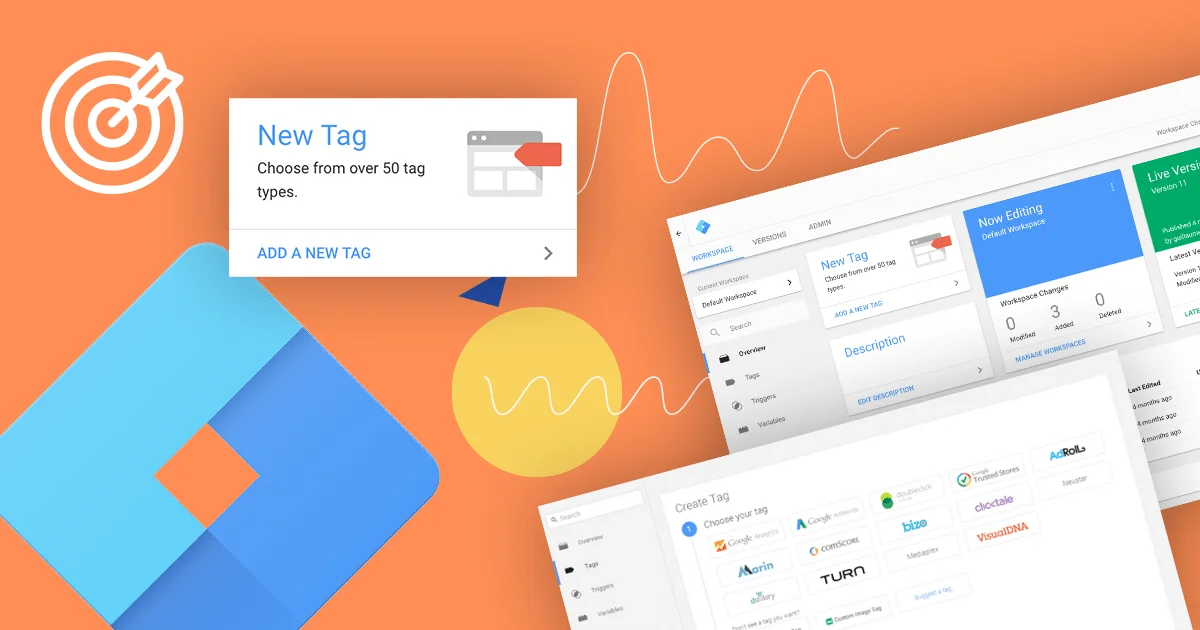
Understanding Google Tag Manager: Pros, Cons, and Practical Examples for Landing Pages
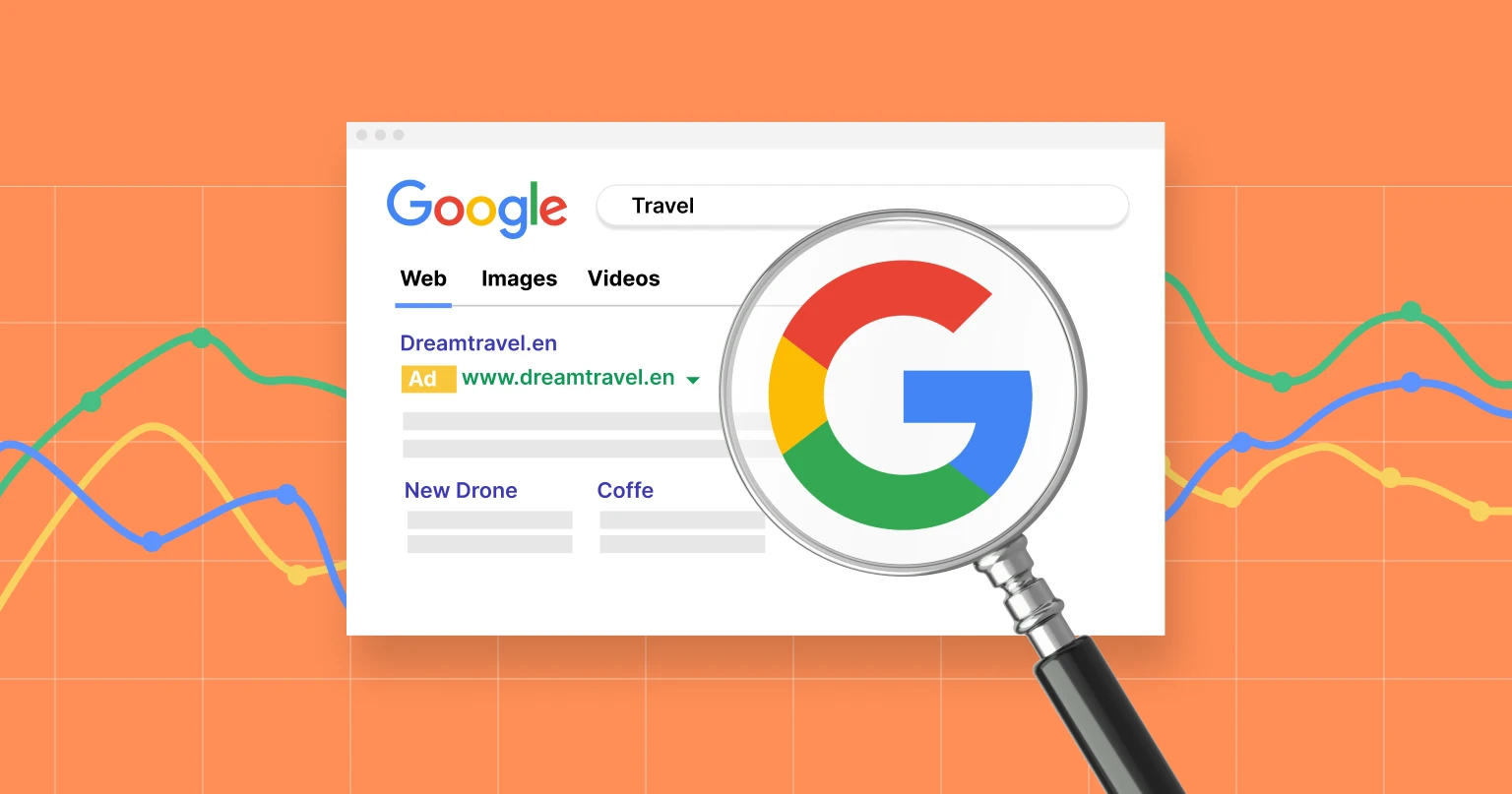
Optimizing User Experience for SEO Success: A Guide to Google Page Experience Algorithm Update
The Unbeatable Duo of Call Tracking and Page Optimization
- Reviews / Why join our community?
- For companies
- Frequently asked questions
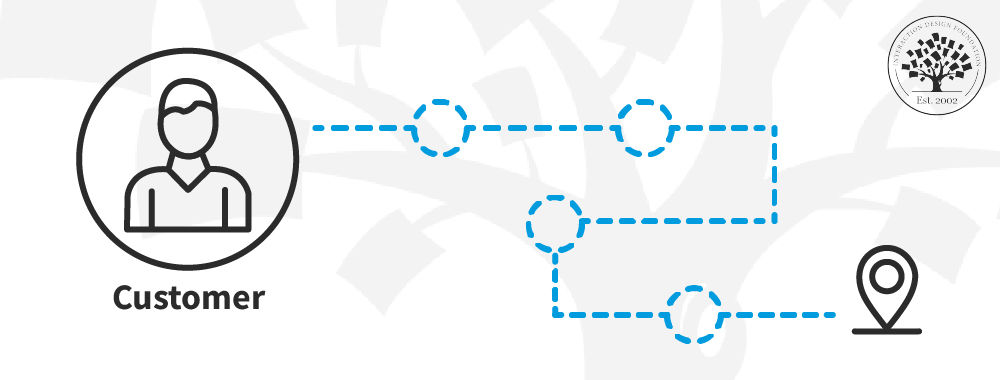
Top 5 Customer Journey Mapping Tools (+ Templates)
As the digital world continues to change, you must know more about your customer's journey. Customer Journey maps help you see and analyze how customers interact with your brand. You can improve marketing strategies and customer experiences using them. Let's explore customer journey mapping tools and top templates that you can use to understand customer behavior better and create customer-centric products and services.
A customer journey map is a visual storyline of a customer's experience with a brand—from initial contact to long-term engagement. Such maps are crucial for you to understand and improve customer interactions. With the right tools, creating these maps becomes easier and more effective.
Explore the top five customer journey mapping tools and templates to streamline your design efforts and elevate the customer experience.
But first, let’s get into some basics.
Why Use a Customer Journey Map?
Customer journey maps serve a specific purpose : to show customers' paths with your brand. They reveal insights into customer interactions. Let’s understand how customer journey maps contribute to a more customer-centric business approach.
Matt Snyder, Head of Product and Design at Hivewire, discusses the power of journey mapping.
- Transcript loading…
1. Enhance Customer Understanding
Creating a journey map fosters a deep understanding of your customers. You see their experience through their eyes. This insight helps you create a customer experience design and tailor services to their needs, which will ultimately lead to higher satisfaction and loyalty.
2. Identify Pain Points
Mapping the customer journey highlights areas where customers face challenges. You can work on solutions as you identify these pain points.
3. Boost Cross-Functional Collaboration
Journey maps bring various teams together, from marketing to product development . This collaboration ensures a cohesive strategy. It can enhance the consistency and quality of customer interactions across all touchpoints.
4. Informed Decisions Based on Real Data
Teams create customer journey maps based on real user data. This helps all stakeholders make informed, strategic decisions that are aligned to ensure a better match between what customers want and what the business offers.
5. Foster Innovation
Journey maps inspire innovation in customer experience. They reveal opportunities and spark new ideas that could lead to breakthroughs in brand engagement. This innovation shapes how you connect with your audience.
How to Create a Customer Journey Map
Creating a journey map is a strategic process that unveils how customers interact with your brand. It provides a detailed overview of their experience, from initial contact to post-purchase engagement. This section guides you through the essential steps to craft a comprehensive customer journey map.
Define Your Map’s Business Goal : Determine the purpose of the map and its target audience. Focus on specific user experiences it aims to address.
Conduct Research : Gather data on customer experiences across all touchpoints. Collect statistical and anecdotal evidence using customer interviews , surveys , and social media insights.
Whether it’s an interview or a survey , the quality of the results depends on the quality of the questions. Watch William Hudson, UX expert and Author, discuss how to write good questions.
Review Touchpoints and Channels : Identify all customer touchpoints and channels. Customers may make online bill payments or do other work through your app.
Make a Persona : Create a customer persona where you understand customer actions, thoughts, feelings, and needs. You must identify barriers and annoyances.
Sketch the Journey : Combine all elements, including touchpoints, timescale, and persona. Illustrate the customer's path through these elements. Note down their emotions at each stage.
Iterate and Refine : Continuously improve your sketch with the aim of an ideal representation of the customer journey.
Share with Stakeholders : Ensure all stakeholders understand the map’s significance. It helps you enhance customer experiences and benefit the organization.
Tools and Software for Customer Journey Mapping
The right tools for customer journey mapping can make a significant difference. We’ll discuss the top five tools and provide a starter template for each tool to help you get started. This synergy ensures you extract maximum value from the tool and its accompanying template. Let's explore some of the top options available.
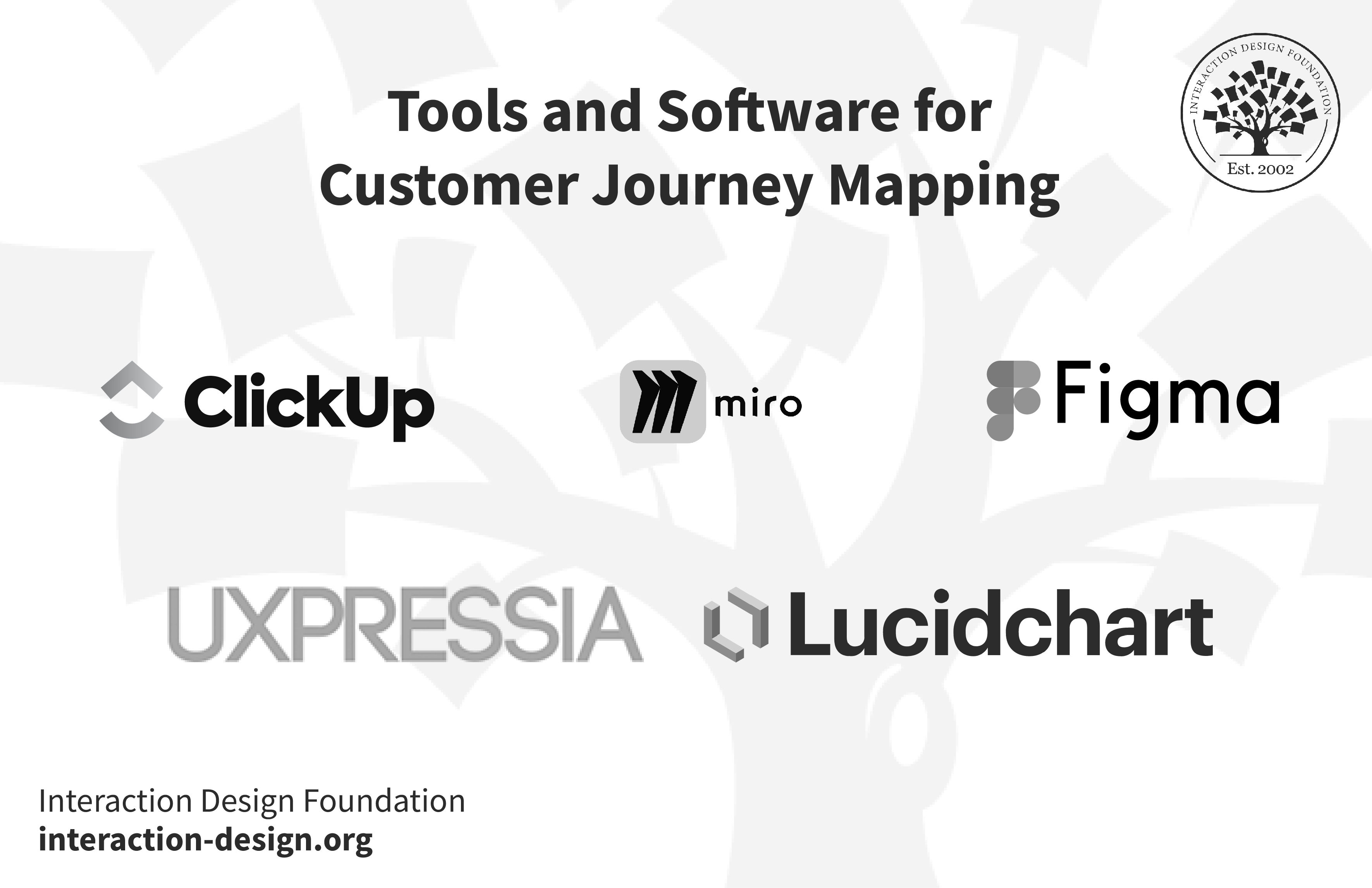
© Interaction Design Foundation, CC BY-SA 4.0
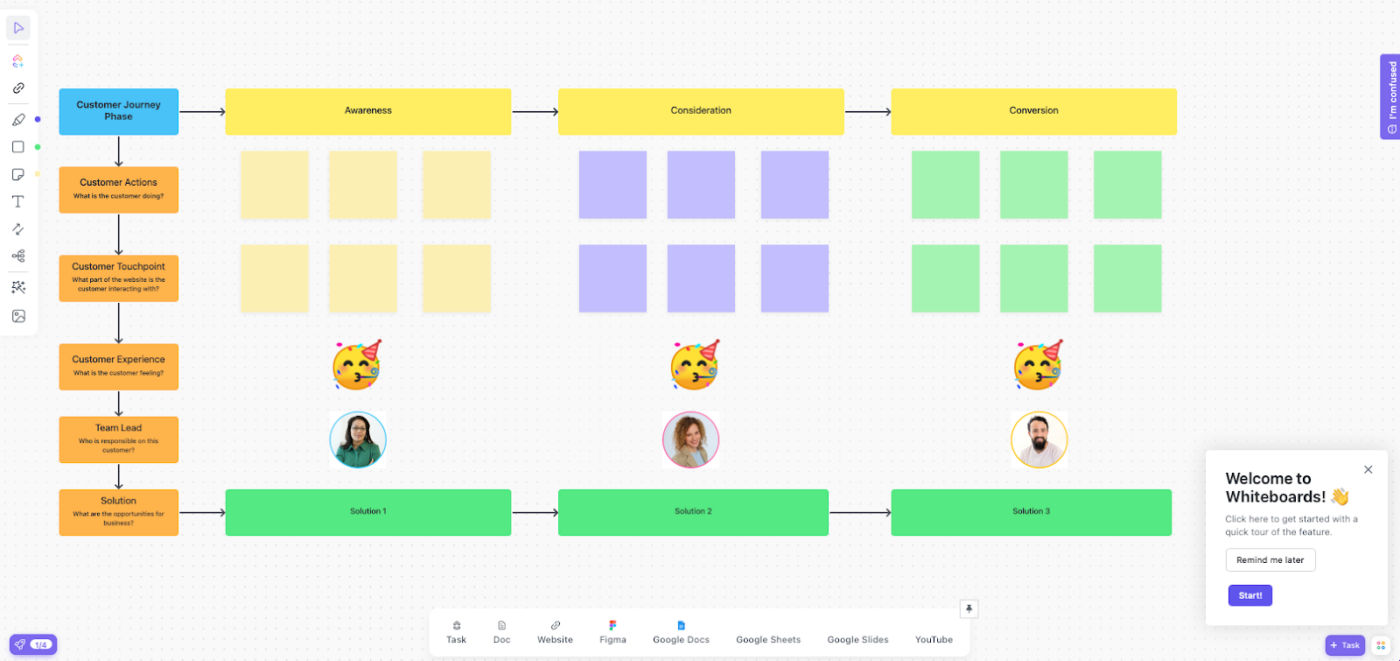
© ClickUp, Fair Use
ClickUp stands out for crafting outstanding customer journey maps. You can visualize your workflow using its whiteboard tool and mind map creator. These tools allow you to map out every stage of your customer's journey, including awareness, purchase, repeat buying, and churn.
Additionally, ClickUp provides a variety of pre-made templates for customer journey maps. This saves time and effort. The Mind Maps feature lets you set up detailed workflows and approval processes. It simplifies the task of assigning dependencies for each step.
Best Features
Whiteboard to visualize ideas.
Mind Map Maker for dynamic outlines and flowcharts.
Customizable templates for different use cases.
Variety of views for task management and journey mapping.
Limitations
Numerous customizations can be overwhelming.
A steep learning curve for new users.
Free Forever plan.
Unlimited: $7/month per user.
Business: $12/month per user.
Enterprise: Custom pricing.
ClickUp’s Customer Journey Map Template
ClickUp's customer journey map template helps teams visualize the customer's path. It allows teams to track actions, touchpoints, and experiences for strategic improvements. This tool fosters collaboration, as team leads can oversee the journey for a seamless customer experience from awareness to conversion.
Get the template
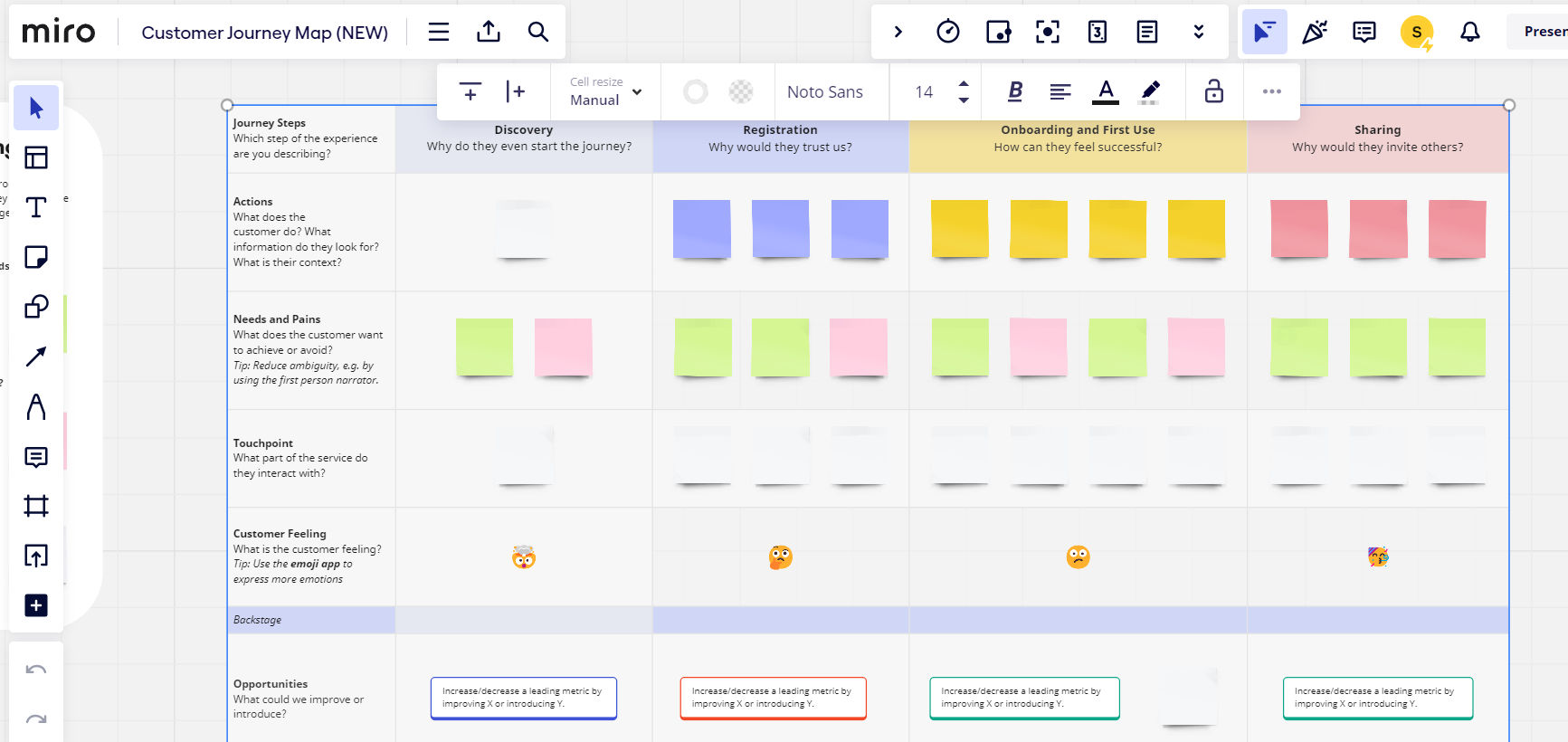
© Miro, Fair Use
Miro is a versatile digital whiteboarding platform. It excels in facilitating remote collaboration across teams. You can use Miro for brainstorming , project planning, and customer journey mapping. Its intuitive interface and extensive template library make it a popular choice.
Expansive template library for various use cases.
Real-time collaboration tools for product teams and cross-functional stakeholders.
Integration with popular apps like Slack, Microsoft Team and Jira.
Infinite Canvas offers vast space for mapping complex journeys.
New users may find using Mitro overwhelming due to its extensive features.
Occasional lag with larger boards or when many users collaborate.
Limited customization options in templates.
Basic: Free with limited features.
Starter: $8/month per user.
Business: $16/month per user.
Enterprise: Custom pricing for comprehensive needs.
Miro’s Customer Journey Map Template
This Miro template features a comprehensive customer journey map. It helps teams capture key goals, struggles, actions, touchpoints, and customer feelings. Miro enables collaborative editing and brainstorming to support the process. It makes the mapping exercise highly interactive and efficient.
3. Figjam by Figma
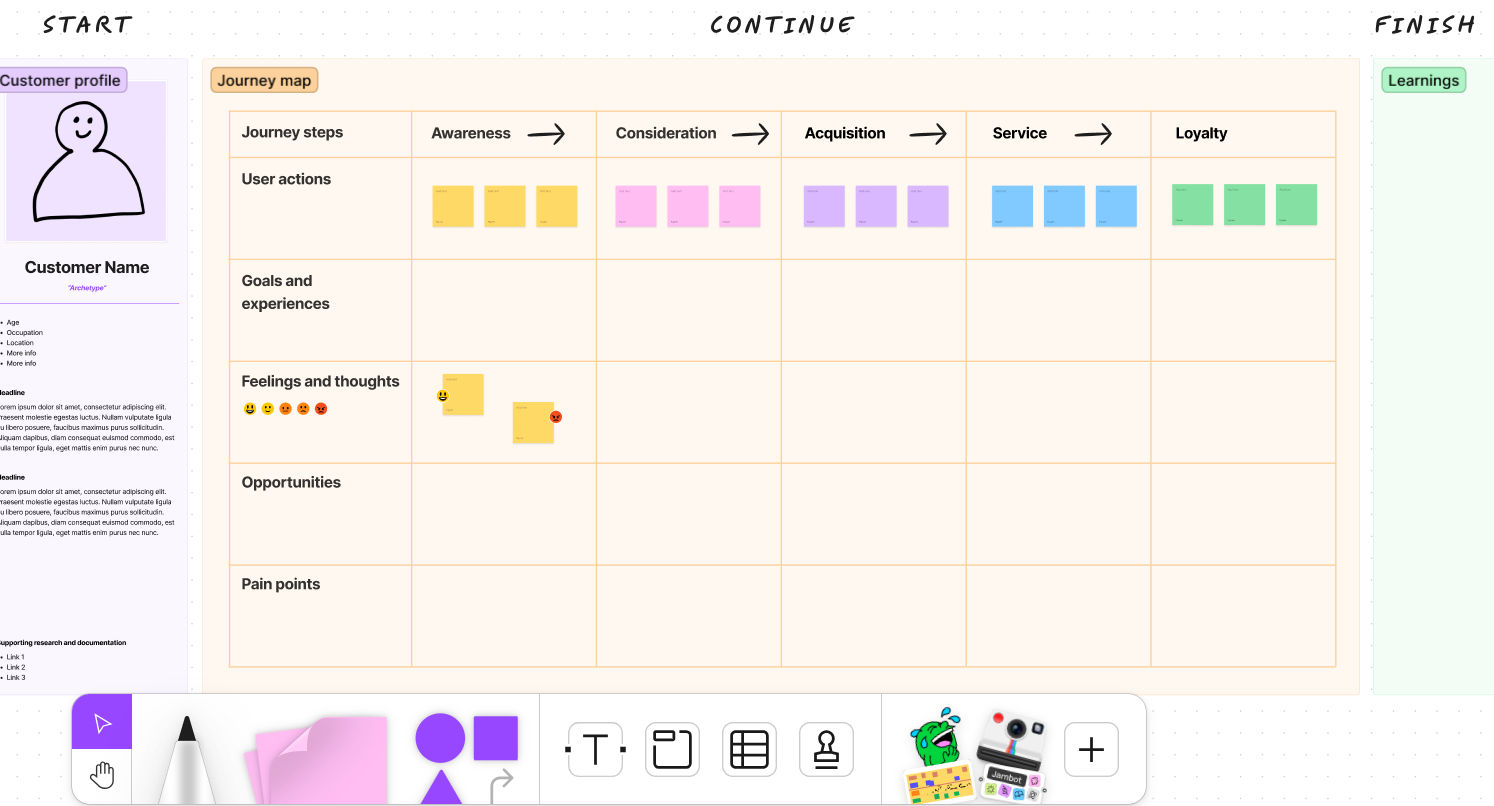
© Figma, Fair Use
Figjam by Figma is an excellent tool for collaborative interface design and prototyping . It lets people and teams create designs from scratch, including customer journey maps.
This tool has a free whiteboarding feature. It's great for sketching designs and wireframes . While mainly for UI/ UX design , it stands differently than other customer journey mapping tools.
Modern pen tool for precise design.
Plugins for automating tasks.
Flexible styles and accessible libraries.
Easy export options for sharing designs.
No offline accessibility .
Difficulty in finding specific resources in the community section.
Limited image manipulation options when you create customer journey maps.
Free plan available.
Professional: $12/month per editor.
Organization: $45/month per editor.
Enterprise: $75/month per editor.
Figjam by Figma’s Customer Journey Map Template
This FigJam template includes a profile section that ensures teams focus on the user. Key sections capture user actions, goals, emotions, opportunities, and challenges. You can document the learnings at the end and add insights for future strategies.
4. Lucidchart

© Lucidchart, Fair Use
Lucidchart is an advanced diagramming tool that creates customer journey maps. It enables teams to collaborate and visualize complex processes, systems, and customer interactions.
Integrates data into diagrams for dynamic mapping.
Generates visual representations from data.
Compatible with Google Workspace, Atlassian, Slack, and more.
Visualization filters to highlight specific parts of the customer journey.
Saves and shares customer personas and journey maps.
Performance lags with large, complex diagrams.
Steep learning curve compared to simpler alternatives.
Issues with low-resolution exports.
Free: $0, offers basic features.
Individual: $7.95/month per user for more advanced capabilities.
Team: $9/month per user, designed for team collaboration.
Enterprise: Custom pricing, suitable for larger organizations with specific needs.
Lucidchart’s Customer Journey Map Template
The Lucidchart template features a persona profile, scenarios , and expectations. Lucidchart offers tools like shape libraries, text formatting options, and diagram key creation for a clear, structured journey visualization in the template.
5. UXpressia
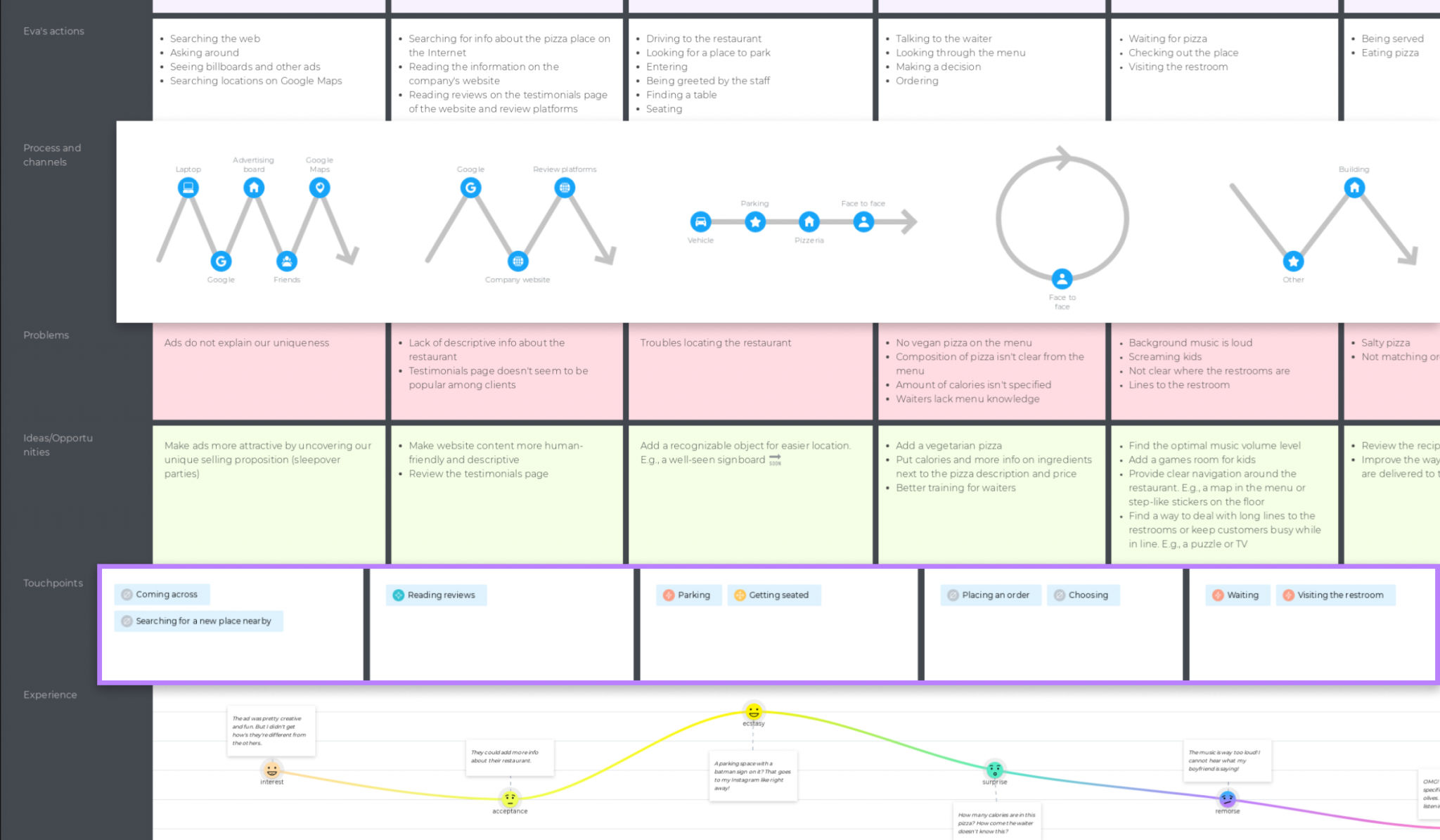
©UXpressia, Fair Use
UXpressia is a leading UX tool for creating customer journey maps, personas, and impact journey maps. It enables individuals and teams to collaborate in real-time. Also, UXpressia offers interactive online courses to help teams with their journey-mapping initiatives.
It has 70+ customer journey maps, personas, and impact map templates.
It has a big list of features to make small and big/complex journey maps.
Comes with integrated web analytics to detail the customer experience.
Its presentation mode displays journey maps online.
Allows exports with custom branding.
Limited features and unintuitive workflow
Steep learning curve
Starter: $16/month per user
Pro: $36/month per user
Enterprise: Contact the UXPressia sales team for pricing
UXpressia’s Customer Journey Map Template
UXpressia offers a blank canvas for a customer journey map segmented into stages like Aware, Join, Use, Develop, and Leave. It's structured to define user goals , processes, channels, problems, and experiences. The design encourages adding personas for tailored journey mapping. You can change the positioning of stages and add different colors to each stage.
Design Your Own Customer Journey Map
Use this five-step approach to map your customer’s experience:
Add a Persona : You can create a persona representing a typical customer. Add detailed information about this persona at the top of the map. Include their demographics and characteristics relevant to the journey.
Add Phases : Divide the customer experience into key segments or phases. Each phase column will include the persona's thoughts and actions later.
Add Actions : Next, detail the actions and thoughts of the persona in each phase based on user research findings.
Add Trends : Here, you include quantitative measures that show how the experience changes over time. These could be survey results or any relevant data that suggests fluctuations in the journey.
Add Narrative Facts : This step uses qualitative and quantitative elements from user research. You can add quotes from the persona or significant data points explaining the highs and lows in the journey. You may include any roadblocks the customer faces.
You can use the IxDF Customer Journey Map Template as a handy reference to quickly design your map.

This template helps you map crucial parts of the customer journey to make informed design decisions. It keeps the process simple and uses standard data representation methods.
Customer journey maps don’t need to follow a specific format; you can tailor them to suit your project. Here’s another example, along with a blank template to inspire your map.
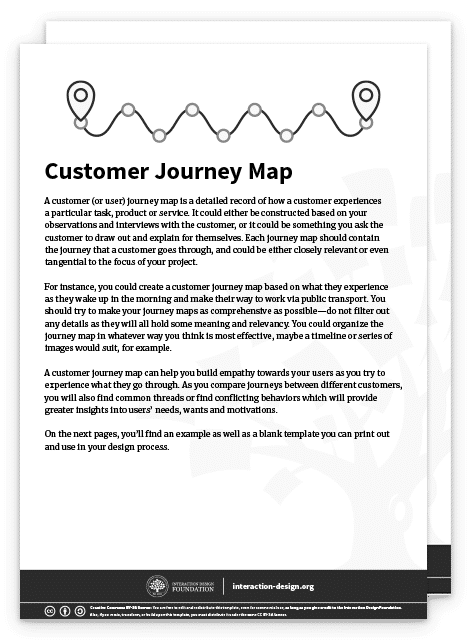
The Take Away
Customer journey maps help teams understand the customer's experience and reveal pain points, emotions, and interactions. Use these maps to:
Understand customer experiences to tailor strategies for each stage of their journey.
Consider customer emotions and pain points as significant influencers in their decision-making.
As a visual tool to capture these insights and guide business strategies.
To optimize customer experiences or identify new business opportunities.
These insights help you create a delightful and compelling customer journey.
Where to Learn More
The topic Customer Journey Map: Definition & Process .
Take our course Journey Mapping
Read Hubspot’s Whitepaper on the Customer Journey Map
Information Visualization

Get Weekly Design Insights
What you should read next, the top 6 insights from our agile methods for ux design course.

- 7 hours ago
Mobile UI Design: Top Insights from the IxDF Course
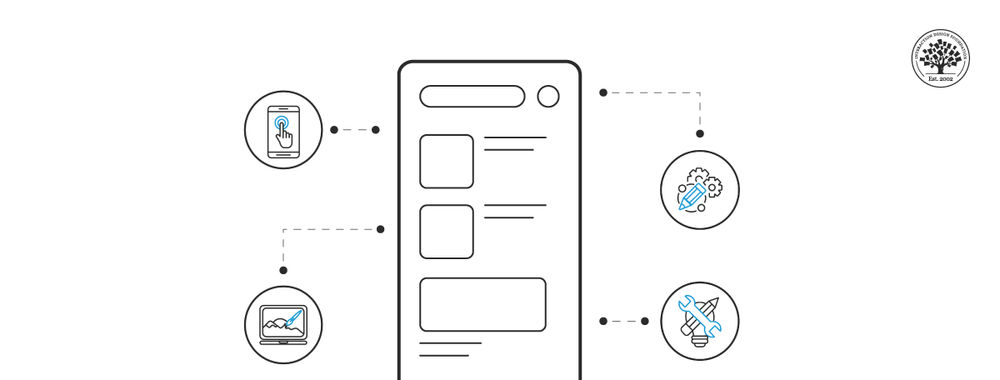
How to Create Effective Journey Maps: Learnings from the IxDF Course
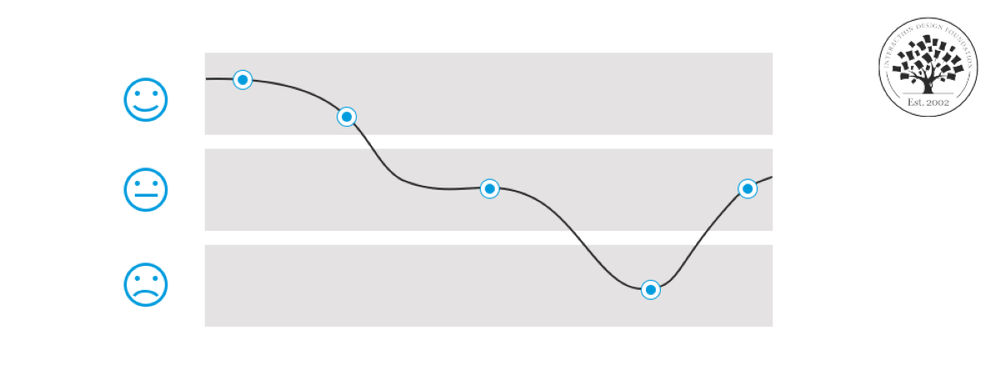
Master Mobile Experiences: 5 Key Discoveries from the IxDF Course
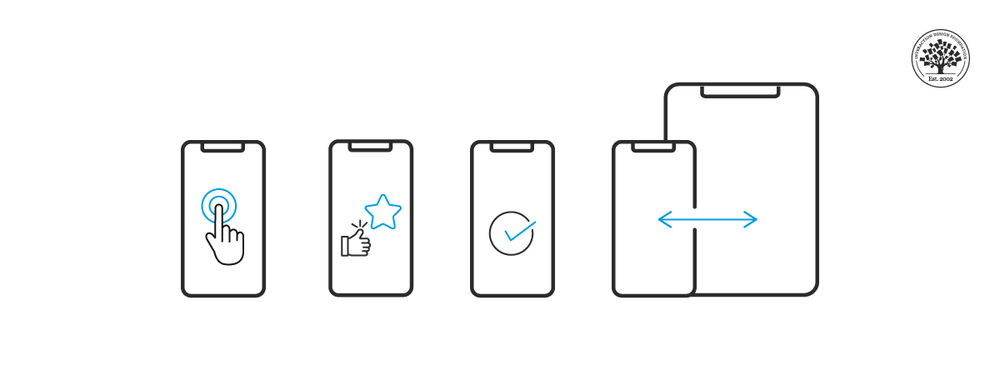
Personas for Mobile UX Design

- 2 weeks ago
Interaction Design Foundation Reviews: Answers to frequently asked questions by members
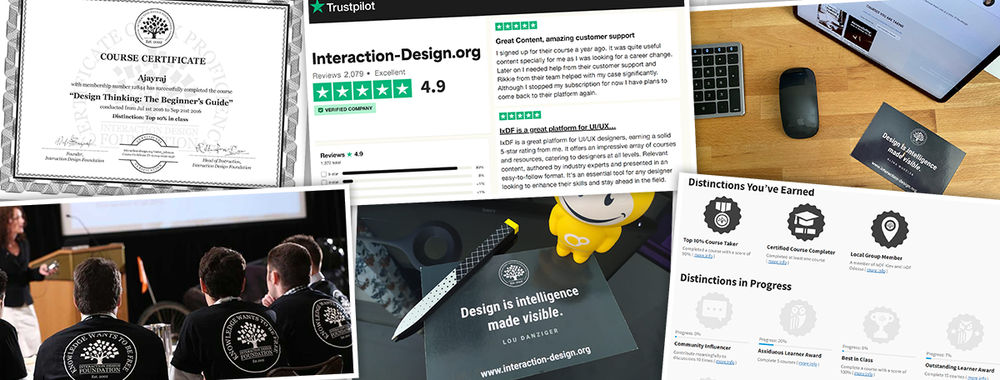
- 3 weeks ago
10 UI Designer Portfolio Examples

What Tech Job is Right for Me? A Comprehensive Guide to Navigating Your Career Path

How to Succeed as a Designer on Agile Teams: Embrace Imperfection

- 4 weeks ago
Your Guide to Hamburger Menus

Open Access—Link to us!
We believe in Open Access and the democratization of knowledge . Unfortunately, world-class educational materials such as this page are normally hidden behind paywalls or in expensive textbooks.
If you want this to change , cite this article , link to us, or join us to help us democratize design knowledge !
Privacy Settings
Our digital services use necessary tracking technologies, including third-party cookies, for security, functionality, and to uphold user rights. Optional cookies offer enhanced features, and analytics.
Experience the full potential of our site that remembers your preferences and supports secure sign-in.
Governs the storage of data necessary for maintaining website security, user authentication, and fraud prevention mechanisms.
Enhanced Functionality
Saves your settings and preferences, like your location, for a more personalized experience.
Referral Program
We use cookies to enable our referral program, giving you and your friends discounts.
Error Reporting
We share user ID with Bugsnag and NewRelic to help us track errors and fix issues.
Optimize your experience by allowing us to monitor site usage. You’ll enjoy a smoother, more personalized journey without compromising your privacy.
Analytics Storage
Collects anonymous data on how you navigate and interact, helping us make informed improvements.
Differentiates real visitors from automated bots, ensuring accurate usage data and improving your website experience.
Lets us tailor your digital ads to match your interests, making them more relevant and useful to you.
Advertising Storage
Stores information for better-targeted advertising, enhancing your online ad experience.
Personalization Storage
Permits storing data to personalize content and ads across Google services based on user behavior, enhancing overall user experience.
Advertising Personalization
Allows for content and ad personalization across Google services based on user behavior. This consent enhances user experiences.
Enables personalizing ads based on user data and interactions, allowing for more relevant advertising experiences across Google services.
Receive more relevant advertisements by sharing your interests and behavior with our trusted advertising partners.
Enables better ad targeting and measurement on Meta platforms, making ads you see more relevant.
Allows for improved ad effectiveness and measurement through Meta’s Conversions API, ensuring privacy-compliant data sharing.
LinkedIn Insights
Tracks conversions, retargeting, and web analytics for LinkedIn ad campaigns, enhancing ad relevance and performance.
LinkedIn CAPI
Enhances LinkedIn advertising through server-side event tracking, offering more accurate measurement and personalization.
Google Ads Tag
Tracks ad performance and user engagement, helping deliver ads that are most useful to you.
Share Knowledge, Get Respect!
or copy link
Cite according to academic standards
Simply copy and paste the text below into your bibliographic reference list, onto your blog, or anywhere else. You can also just hyperlink to this article.
New to UX Design? We’re giving you a free ebook!

Download our free ebook The Basics of User Experience Design to learn about core concepts of UX design.
In 9 chapters, we’ll cover: conducting user interviews, design thinking, interaction design, mobile UX design, usability, UX research, and many more!
New to UX Design? We’re Giving You a Free ebook!
Learn / Guides / Customer journey mapping (CJM) guide
Back to guides
The 9 best customer journey mapping tools to grow your business
Customer journey mapping (CJM) software is a digital tool that collects and presents quantitative and qualitative data about how users interact with your product or website so you can better understand your buyer personas and ensure a delightful user experience (UX).
The more complicated the journey, the more data you’ll need to map it out. The right mix of CJM tools gives you data from multiple customer touchpoints and channels so you can collect as much information as possible to map your journey in detail.
Last updated
Reading time.
Customers will interact differently with your site or app depending on what part of the journey they’re in. Since journey maps include everything from awareness—when a customer first sees your ad on Facebook—to onboarding and using your product, the data you rely on to guide your map will vary at each stage.
This article walks you through three types of customer journey mapping software, so you understand how each fits into your different workflow stages and can choose the tool(s) that work best for your business:
Traditional website and behavior analytics tools
Voice-of-the-customer tools for user feedback
Tools to visualize your customer journey map
Website and behavior analytics tools for customer journey mapping
Analytics tools give you insight into who your customers are and how they behave on your website.
Traditional website analytics tools give you quantitative data , including traffic and demographic metrics like bounces and bounce rate , new and returning users , and goal conversion rates .
Behavior analytics tools give you qualitative insight into how users actually experience your website and how they behave during their customer journey. These tools help you pinpoint where users spend time on individual pages, which buttons they click (or don’t), and where they exit from the funnel, so you can improve the user experience.
While traditional analytics tools tell you about the customer’s journey to your website, behavior analytics tools show where their attention goes after they’ve arrived.
Quantitative and qualitative analytics tools work together to help you identify usability issues in your customer journey and highlight opportunities to improve the customer experience .
Here are three popular analytics tools used by marketing and UX professionals to help you kickstart your customer journey mapping process:
Hotjar (hi there! 👋) helps you gain insights into customer behavior with tools like Funnels , Heatmaps , Recordings , Surveys , and a Feedback widget , giving you invaluable data on how users experience your site throughout their journey.
Hotjar Funnels shows you the path of the journey, while Heatmaps and Recordings show you how users behave along the way—where they click and scroll, where they get stuck, and the actions they take as they navigate from page to page. Hotjar’s tools also offer built-in automations—like AI for Surveys —and team collaboration features, including Highlights , which makes insight sharing quick and painless.
Hotjar reveals what numbers don’t. Funnels helped me identify where in the customer journey people drop off. Recorded user sessions let me understand what people see when they arrive on our website—what they click and what they don’t click. Heatmaps helped me identify where they spend most of their time and assess if they should be spending time there or not.
Furthermore, Hotjar Dashboards gives you key user behavior metrics, helping you prioritize how you build and fix your website to provide a better customer journey, which ultimately helps you increase conversions and improve customer satisfaction .
Hotjar complements tools like Google Analytics , giving you a full picture of customer engagement and behavior on your website.
Discover how visitors experience your site
Use Hotjar to gather data and insights into the customer journey so you can make the right changes at the right time for your visitors.
2. Google Analytics 4
Google Analytics 4 is a web analytics tool that tracks and measures website traffic metrics, like bounce and exit rates, goal conversions, sources of traffic, and user demographics.
GA tells you how much traffic your website gets, where it comes from, and which channels convert best. You can also see what your most popular landing pages are and where people are exiting from your website.
💡 Pro tip: traditional analytics and behavior analytics tools work best as a team. 🤜🤛 Combining Hotjar and Google Analytics helps you to paint a more complete picture of your customers’ journey through your site—check out Hotjar’s GA4 integration to unlock the full potential of both tools.
Heap is a no-code product analytics tool that gives you customer data on how people use your product, tracking every stage of the customer journey.
This tool comes in handy when you’re looking for customer pain points with your product and you need data to help you make decisions aimed at increasing customer retention and reducing churn . Heap helps you understand which customer segments your users come from, giving you more granular insight into the customer journey.
Voice of the customer tools for user feedback
Voice-of-the-customer (VoC) tools help you understand your customer needs by capturing what they really think about your business or product , in their own words.
Learning what your customers have to say about their experience helps you get raw, authentic feedback about how they perceive your brand and product at every stage of the journey, giving you deeper insight into customer emotions and motivations that drive their decision-making.
Here are three customer feedback tools to help you understand your users:
Hotjar (hello again! 👋) gives you insights into customer behavior with feedback tools like surveys , user interviews , and a visual feedback widget.
The Hotjar Heatmaps and Recordings tools show you the what and how of user behavior; Surveys and Feedback help you understand the why .
Embed a survey or feedback widget on any page to ask customers what they think about your product experience, giving them the opportunity to share their unique perspectives. Use Hotjar’s Microsoft Teams and Slack integrations to receive survey response notifications in real time, so you and your team members are immediately notified of issues and can react promptly.
💡 Pro tip: the way you ask a question determines what kind of answer you’ll get. Open-ended questions will give you more qualitative data (and can be answered in detail), while closed-ended questions (think ‘yes/no’ questions) can help you create charts based on quantitative user research data.
Before you set up an on-site survey, know what information you want to get from your visitors—and how you’re going to use it—so you can ask questions that’ll get you the data you need.
One of our primary goals as a UX team is to understand the customer’s journey and what they’re doing on the website. Surveys give us the ability to reach out to people in context—we can just pop a survey on a page we want insights on.
2. Clarabridge
Clarabridge is an AI-powered feedback text analytics tool that collects what people say about your brand or business from every possible source and analyzes how they feel about you.
This tool is the way to go if you want to know how people really feel about your brand and business, and what the general user sentiment is. Use Clarabridge when people are already talking about your company: either on your website (through chats and surveys) or off your site (like on social media platforms).
3. InMoment
InMoment is an experience-intelligence (IX), AI-powered feedback tool that helps you get more detailed feedback from users.
For example, if you ask your users about their experience and they say ‘Good’, InMoment prompts them further: ‘What was good?’ It also offers social monitoring that gathers meaningful feedback on what your customers are saying about you online.
Tools to visualize your customer journey
Classic customer journey mapping tools are visual flowchart builders: the digital version of sticky notes, only these can be saved in the cloud, shared with your team, and turned into a remote-friendly collaborative workspace.
Once you’ve collected data about your users from user feedback and analytics tools you’ll have enough information to map out the user journey.
When you have a flowchart mapped out, it’ll be easier to:
Identify all customer touchpoints
See which pathways can be simplified
Find opportunities to increase engagement and build customer loyalty
Visualize which touchpoints belong to each part of the funnel
Create clearer CTAs and paths so users can navigate to the next step
Make an impact map to clarify and prioritize product decisions
Here are four tools to create visual and intuitive maps using customer journey software:
Miro is an online whiteboard workspace that’s great for remote teams who want to brainstorm and put their thoughts onto a shared digital whiteboard. The software lets you create a board from scratch—so you can still use your sticky note strategy, just digitally—or use one of their pre-made templates.
U se Hotjar with Miro to bring heatmaps, survey responses, and other analytics data to life. This helps ensure you and your team make data-driven decisions while visualizing your journey. Use this tool the same way you’d use a whiteboard for prototyping, wireframing, diagramming, or roadmapping.
2. UXPressia
UXPressia’s main functionality is to create customer journey maps. If you need a little more than a whiteboard, UXPressia helps you create consistently good-looking CJMs for your customer personas.
This tool has a beautiful and intuitive interface, perfect for those who want to build maps that impress. You can easily visualize customer touchpoints and customize the maps to your own brand.
UXPressia is great for when you need a clean design and a tool that lets multiple stakeholders map data across different departments—very useful for real-time collaboration. This tool is also a good option if you're looking for a customer journey map template to help you get started.
Smaply is a mapping tool for complex customer journeys, helping you understand channel usage and backstage processes. It lets you create a repository of customer insights, including images, PDF files, and even audio files to link all your data together and get a full overview of the customer journey. Plus, it integrates with project management tools like Jira (which in turn integrates with Hotjar ).
Use this tool when you have a complex customer journey and you want to keep everything in one, easy-to-navigate place.
Gliffy is a fast and easy-to-use collaborative tool that lets you draw out large diagrams. You can drag and drop shapes from their library and leave feedback comments, and it also integrates with Google Drive. It stores past map versions and tracks changes, so you can always go back to previous iterations.
Gliffy is a great option when you don’t need a fancy customer journey mapping tool, but something simple yet versatile to get your ideas ‘on paper’.
How to choose the right customer journey mapping tool
The right customer journey mapping tool depends on the complexity of your journey, your level of understanding of the journey, how steep the tool’s learning curve is, the structure of your team, and why you’re mapping the customer journey in the first place—that is, what you want to learn from it.
The most important part isn’t really the tool you pick, it’s how you use it and what you do with the insights you get.
In the next chapter, we’ll dig deeper into why you need customer journey mapping tools and how specific features can help you accomplish your customer experience management goals.
FAQs about customer journey mapping tools
What is a customer journey map.
A customer journey map—sometimes called a user journey map or service blueprint —is a visual representation of how customers interact with and experience your website, products, or business across multiple touchpoints.
What are customer journey mapping tools?
Customer journey mapping tools are digital tools that collect and present quantitative and qualitative data about how users interact with your product or website.
Customer journey tools—also known as user journey mapping tools—tell you where your visitors come from, how they behave on your website, and what they think about their experience.
What are the best customer journey mapping tools?
The right mix of CJM tools gives you data from multiple customer touchpoints and channels so you can collect as much information as possible to map your journey in detail. Use one or a combination of these tools to create a customer journey that delights your buyers:
Google Analytics 4
Clarabridge
CJM tips and how-tos
Previous chapter
CJM tools: features and how to choose
Next chapter
The 2024 Top 10 ERP Systems Report
Our experts have highlighted ten vendors that can help your organization make data-driven decisions.
The 2024 ERP Report
Every year, Panorama analyzes industry trends to understand organizations’ selection and implementation practices when it comes to enterprise software.
ERP selection & implementation
Management consulting
Software Expert Witness
The 2023 Top Government ERP Systems Report
This independent report reveals what ERP vendors our consultants most frequently consider for public sector clients.
Reports & Whitepapers
Tools & Resources
Events, Webinars & Podcasts
ERP Consultations
Popular Blogs
Top 10 ERP Software
Our list of top 10 ERP software highlights the vendors our ERP experts have found to be innovative and strong in functionality. This is an overview of those ERP systems.
Blog Collection
Challenges With Customer Journey Mapping That Can Lead to ERP Failure
by Bill Baumann | Jun 13, 2022

As a business leader, you might not have guessed that your customer journey was the linchpin to ERP success, but we’re here to tell you that a convoluted customer journey map can have all sorts of unexpected impacts on your ERP implementation .
If you don’t address the challenges with customer journey mapping (CJM), your process improvement efforts will veer off track, affecting both your ERP selection and implementation.
Creating a seamless customer experience isn’t easy, so today, we’re looking at some of the most common CJM issues, and how you can avoid them.
5 Challenges With Customer Journey Mapping
1. underplaying the importance of cjm.
Customer journey mapping is more than a strategic exercise. It’s more than a workshop. It’s a critical tool that gives you deep visibility into how people are finding your brand, interacting with your content, and ultimately, making a purchase.
If you don’t know how these steps happen and the sequence in which they happen, it’s easy to develop an incomplete customer journey map. You may over-invest in one area and under-invest in another. As a result, your target audience suffers.
Incomplete customer journey maps often fail to outline buyer personas , including buyer needs, wants, and chief motivators. Without these insights, you’ll struggle to improve the customer experience because you don’t know what pain points to solve or what strengths to draw on.
Too often, business leaders assume that if sales numbers are up, customers are happy. Then, they wonder what happened when those numbers take a nosedive.
Considering this, you should ensure that executives and decision-makers understand the importance of a full customer journey map. The insights you glean from CJM inform every part of your business, including the enterprise software you select. Ideally, these insights will guide you toward a CRM system, manufacturing ERP system , or supply chain management system, that captures the right information from the right locations and puts that data right at your fingertips.
(Learn about the top 10 ERP software .)
2. Failing to Establish a Customer-Focused Culture
One person might find your brand via a website. Another may find and interact with it on social media. Then, there are prospects who you target through email or an SMS text campaign.
Optimizing these touchpoints should be a collaborative effort as it isn’t just one department doing all the work. It’s the IT team. It’s the marketing employees. It’s the sales crew, the HR group, and the C-suite.
Unless all these stakeholders are working together to optimize the customer journey, it’s easy for your process improvement efforts to fail. Groups will form into siloes that don’t communicate with one another, work gets duplicated, and there’s no cohesive look or feel to your brand.
This is why your organizational culture must change as your business needs evolve. If everyone is working for themselves and there’s no cross-department teamwork, you should put plans in place to change your culture and put the customer first.
Contemplating litigation?
We have multiple software expert witnesses available for provision of reports, depositions, and testimonies.
3. Only Including Touchpoints
Yes, a CJM will include touchpoints. However, that isn’t all it should include.
The customer journey might end when a buyer clicks “checkout,” but the path to purchase is more nuanced than you might realize. Most of the time, it will also contain steps that don’t include your business at all.
By limiting your map to only those interactions that involve your brand, you miss opportunities to add value to the journey. Even if you don’t have a presence at a certain part of the experience, you can unlock new areas for growth and expansion when you take a big-picture look at how customers find, work with, and purchase from your business.
4. Continuing to Use Outdated Software
A key challenge with customer journey mapping is mapping a stellar journey and then failing to consider all the technology needed to support it.
As part of your ERP system implementation , are you planning on replacing all your outdated systems? You may want to consider doing so as many companies’ existing legacy systems can’t support an optimized customer journey.
You need software that can capture the right data points and deliver them to your users. This becomes even more important when you consider that a typical customer journey isn’t linear. In fact, they may take multiple different journeys, including sub-journeys and tangent journeys, before they make a purchase decision.
If your systems aren’t integrated, you might miss some of these key interactions. This means users have limited access to the data they need to cultivate relationships, delight customers, and continue to improve the path to purchase.
5. Only Focusing on Brand Advocates
Customer interviews can help you learn more about how buyers perceive your brand. You can use this information in your CJM, but make sure it’s well-rounded.
In addition to feedback from loyal, happy customers and brand advocates , you also need insights from non-loyal ones. These might be people who purchased from your brand once but never came back. Or, they haven’t purchased at all because something is holding them back.
By hearing these perspectives, it’s easier to see where there are gaps in your customer journey and the changes you need to make to correct them.
CJM Success Drives Digital Transformation Success
When a customer experiences your brand via a touchpoint, like social media, email, or live chat, you have the opportunity to make a connection. By investing in CJM as part of your ERP project, you can understand every step a customer takes before purchase and optimize the buyer journey at every touchpoint.
While there can be challenges with customer journey mapping, such as obtaining buy in or capturing the right level of detail, these challenges don’t have to throw your project off track. Our business process management consultants can help you use CJM to drive ERP and digital transformation success. Contact us below for a free consultation.
About the author

Bill Baumann

Posts You May Like:

Technology Trends in the Food and Beverage Industry (CIOs, Take Note)
In the food and beverage sector, technological advancements are helping organizations enhance operational efficiency and reshape consumer interactions. As a CIO, it’s essential to understand the latest technology trends in the food and beverage industry. This post...

HRIS vs HCM vs HRMS: What’s the Difference?
With the rapid pace of digital change in the HR sector, companies must thoroughly understand the variety of HR solutions available to them. Three options that many organizations consider include HRIS, HCM, and HRMS. Today, we’re breaking down the meaning behind these...
Privacy Overview
We have updated our terms and conditions and privacy policy Click "Continue" to accept and continue with ET Retail
We use cookies to ensure best experience for you
We use cookies and other tracking technologies to improve your browsing experience on our site, show personalize content and targeted ads, analyze site traffic, and understand where our audience is coming from. You can also read our privacy policy , We use cookies to ensure the best experience for you on our website.
By choosing I accept, or by continuing being on the website, you consent to our use of Cookies and Terms & Conditions .
- Leaders Speak
- Winning luxury customers by mapping customer experience journey
Luxury brands must strive to truly understand their customers’ motivations, aspirations and unmet needs. What experiences delight their customers? How can they cultivate wow moment for their customers at each touch point? What are challenges faced by them? Knowing your customer’s experience at each stage of their purchase journey will help them device appropriate improvement strategies ahead of time.
- Dr Sheetal Jain ,
- Updated On Apr 29, 2024 at 12:14 PM IST

- Immediately work on fixing the negative experiences encountered by the customers in their journey
- Add more positive (Aha!) moments to their journey
- Develop guidelines and sales training programmes on handling MOT
- Find the moments when excellent service is delivered, incentivize the staff and motivate them to continue to outperform
- By Dr Sheetal Jain ,
- Published On Apr 29, 2024 at 12:11 PM IST
All Comments
By commenting, you agree to the Prohibited Content Policy
Find this Comment Offensive?
- Foul Language
- Inciting hatred against a certain community
- Out of Context / Spam
Join the community of 2M+ industry professionals
Subscribe to our newsletter to get latest insights & analysis., download etretail app.
- Get Realtime updates
- Save your favourite articles
- Winning luxury customers
- luxury customers
- customer experience journey
- luxury brands
- moments of truth
- humanized branding
Root out friction in every digital experience, super-charge conversion rates, and optimize digital self-service
Uncover insights from any interaction, deliver AI-powered agent coaching, and reduce cost to serve
Increase revenue and loyalty with real-time insights and recommendations delivered to teams on the ground
Know how your people feel and empower managers to improve employee engagement, productivity, and retention
Take action in the moments that matter most along the employee journey and drive bottom line growth
Whatever they’re are saying, wherever they’re saying it, know exactly what’s going on with your people
Get faster, richer insights with qual and quant tools that make powerful market research available to everyone
Run concept tests, pricing studies, prototyping + more with fast, powerful studies designed by UX research experts
Track your brand performance 24/7 and act quickly to respond to opportunities and challenges in your market
Explore the platform powering Experience Management
- Free Account
- For Digital
- For Customer Care
- For Human Resources
- For Researchers
- Financial Services
- All Industries
Popular Use Cases
- Customer Experience
- Employee Experience
- Employee Exit Interviews
- Net Promoter Score
- Voice of Customer
- Customer Success Hub
- Product Documentation
- Training & Certification
- XM Institute
- Popular Resources
- Customer Stories
- Market Research
- Artificial Intelligence
- Partnerships
- Marketplace
The annual gathering of the experience leaders at the world’s iconic brands building breakthrough business results, live in Salt Lake City.
- English/AU & NZ
- Español/Europa
- Español/América Latina
- Português Brasileiro
- REQUEST DEMO
- Experience Management
- Customer Journey Mapping
- Customer Journey Stages
See how XM for Customer Frontlines works
The complete guide to customer journey stages.
12 min read If you want to turn a potential customer into a lifetime one, you’ll need to get to know every step of the entire customer journey. Here’s why the secret to customer retention lies in knowing how to fine-tune your sales funnel…
What is the customer journey?
What do we actually mean when we talk about the customer journey? Well, the simplest way to think about it is by comparing it to any other journey: a destination in mind, a starting point, and steps to take along the way.
In this case, the destination is not only to make a purchase but to have a great experience with your product or service – sometimes by interacting with aftersale customer support channels – and become a loyal customer who buys again.
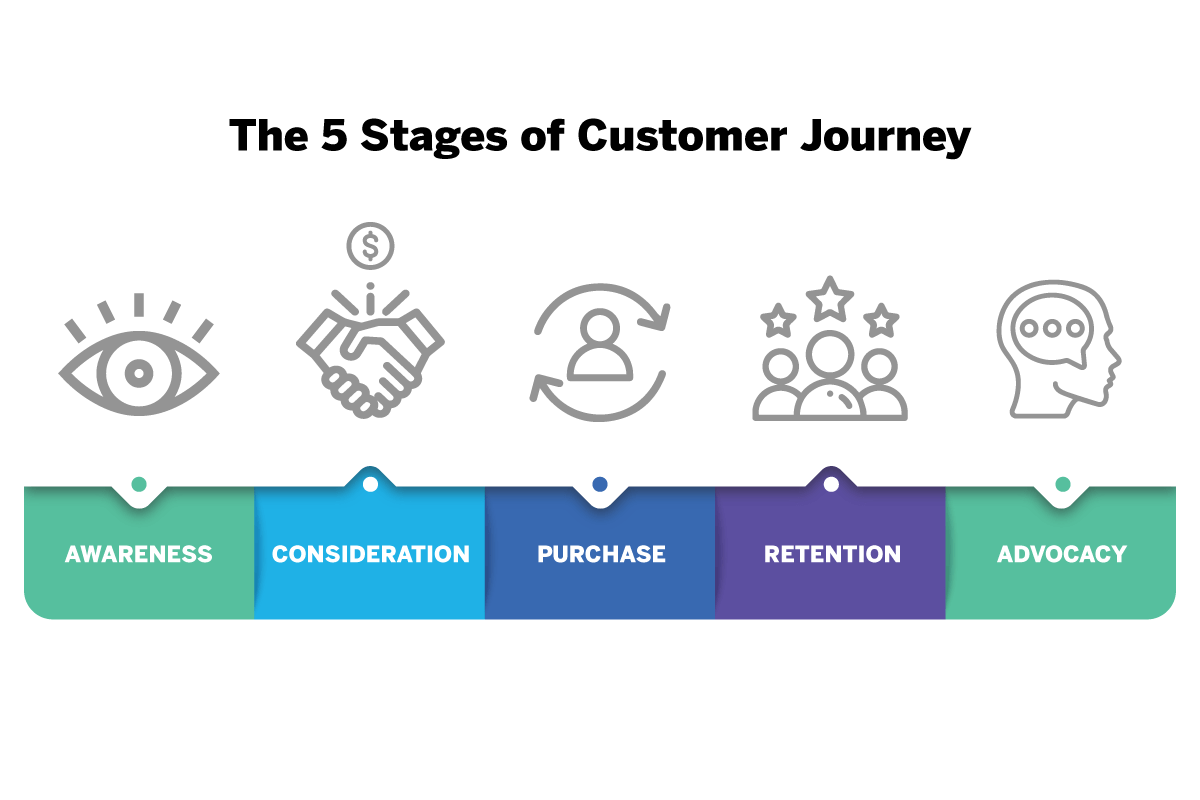
And, just like how you can’t arrive at your vacation resort before you’ve done you’ve found out about it, the customer journey starts with steps to do with discovery, research, understanding, and comparison, before moving on to the buying process.
“Maximizing satisfaction with customer journeys has the potential not only to increase customer satisfaction by 20% but also lift revenue up by 15% while lowering the cost of serving customers by as much as 20%”
– McKinsey, The Three Cs of Customer Satisfaction
In short, the customer journey is the path taken by your target audience toward becoming loyal customers. So it’s really important to understand – both in terms of what each step entails and how you can improve each one to provide a maximally impressive and enjoyable experience.
Every customer journey will be different, after all, so getting to grips with the nuances of each customer journey stage is key to removing obstacles from in front of your potential and existing customers’ feet.
Free Course: Customer Journey Management & Improvement
What are the essential customer journey stages?
While many companies will put their own spin on the exact naming of the customer journey stages, the most widely-recognized naming convention is as follows:
- Consideration
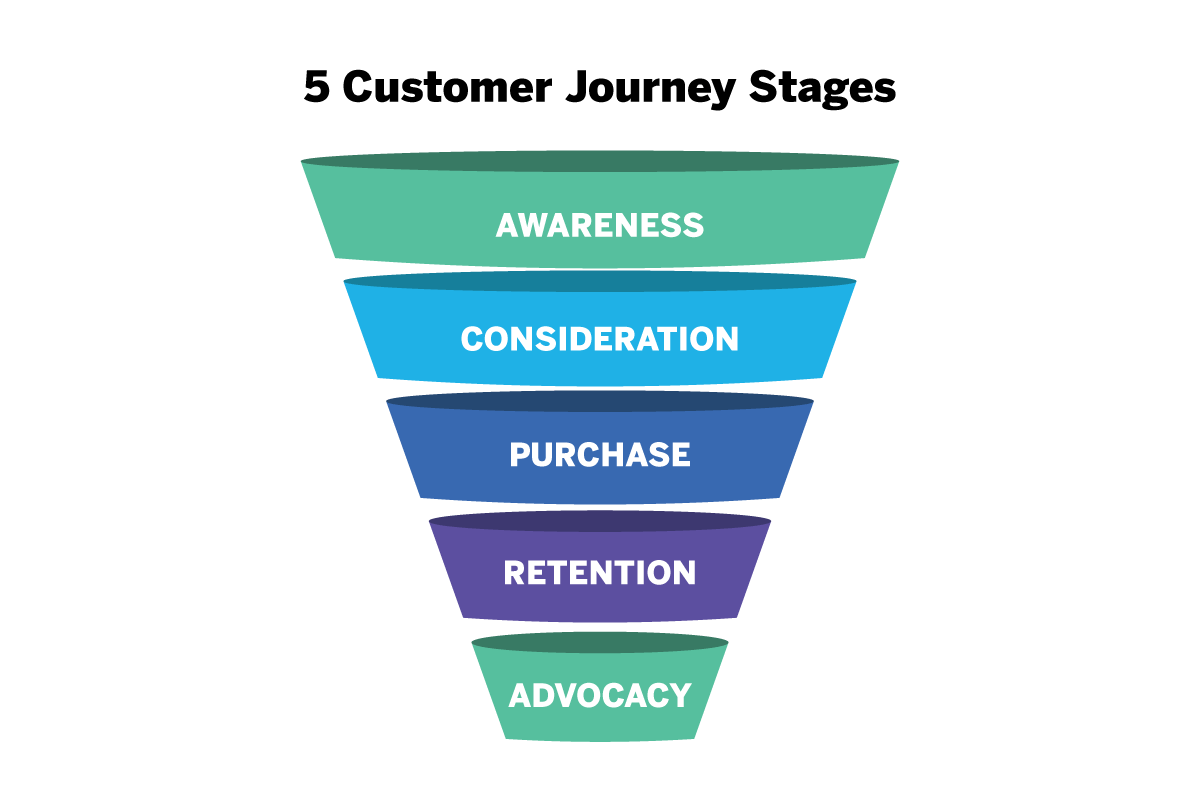
These steps are often then sub-categorized into three parts:
- Sale/Purchase
It’s important to understand every part of the puzzle, so let’s look at each sub-category and stage in turn, from the awareness and consideration stage, right through to advocacy:
Customer journey: Pre-sale
In the pre-sale phase, potential customers learn about products, evaluate their needs, make comparisons, and soak up information.
Awareness stage
In the awareness stage, your potential customer becomes aware of a company, product, or service. This might be passive – in that they’re served an ad online, on TV, or when out and about – or active in that they have a need and are searching for a solution. For example, if a customer needs car insurance, they’ll begin searching for providers.
Consideration stage
In the consideration stage, the customer has been made aware of several possible solutions for their particular need and starts doing research to compare them. That might mean looking at reviews or what others are saying on social media, as well as absorbing info on product specs and features on companies’ own channels. They’re receptive to information that can help them make the best decision.
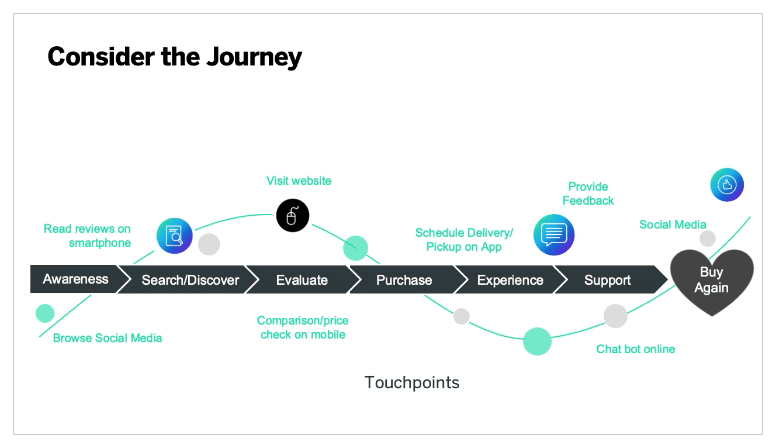
Customer journey: Sale
The sale phase is short but pivotal: it’s when the crucial decision on which option to go with has been made.
Decision stage
The customer has all the information they need on the various options available to them, and they make a purchase. This can be something that’s taken a long time to decide upon, like buying a new computer, or it can be as quick as quickly scouring the different kinds of bread available in the supermarket before picking the one they want.
Customer journey: Post-sale
Post-sale is a really important part of the puzzle because it’s where loyal customers , who come back time and again, are won or lost.
Retention stage
The retention stage of the customer journey is where you do whatever you can to help leave a lasting, positive impression on the customer, and entice them to purchase more. That means offering best-in-class customer support if they have any issues, but it also means being proactive with follow-up communications that offer personalized offers, information on new products, and rewards for loyalty.
Advocacy stage
If you nail the retention phase, you’ll have yourself a customer who not only wants to keep buying from you but will also advocate on your behalf. Here, the customer will become one of the most powerful tools in your arsenal, in that they’ll actively recommend you to their friends, family, followers, and colleagues.
What’s the difference between the customer journey and the buyer’s journey?
Great question; the two are similar, but not exactly the same. The buyer’s journey is a shorter, three-step process that describes the steps taken to make a purchase. So that’s awareness , consideration, and decision . That’s where things stop, however. The buyer’s journey doesn’t take into account the strategies you’ll use to keep the customer after a purchase has been made.
Why are the customer journey stages important?
The short answer? The customer journey is what shapes your entire business. It’s the method by which you attract and inform customers, how you convince them to purchase from you, and what you do to ensure they’re left feeling positive about every interaction.
Why this matters is that the journey is, in a way, cyclical. Customers who’ve had a smooth ride all the way through their individual journeys are more likely to stay with you, and that can have a massive effect on your operational metrics.
It’s up to five times more expensive to attract a new customer than it is to keep an existing customer, but even besides that: satisfied customers become loyal customers , and customer loyalty reduces churn at the same time as increasing profits .
So companies looking to really make an impact on the market need to think beyond simply attracting potential customers with impressive marketing, and more about the journey as a whole – where the retention and advocacy stages are equally important.
After all, 81% of US and UK consumers trust product advice from friends and family over brand messaging, and 59% of American consumers say that once they’re loyal to a brand, they’re loyal to it for life.
Importantly, to understand the customer journey as a whole is to understand its individual stages, recognize what works, and find things that could be improved to make it a more seamless experience. Because when you do that, you’ll be improving every part of your business proposition that matters.
How can you improve each customer journey stage?
Ok, so this whole customer journey thing is pretty important. Understanding the customer journey phases and how they relate to the overall customer experience is how you encourage customers to stick around and spread the news via word of mouth.
But how do you ensure every part of the journey is performing as it should? Here are some practical strategies to help each customer journey stage sing…
1. Perform customer journey mapping
A customer journey map takes all of the established customer journey stages and attempts to plot how actual target audience personas might travel along them. That means using a mix of data and intuition to map out a range of journeys that utilize a range of touch points along the way.
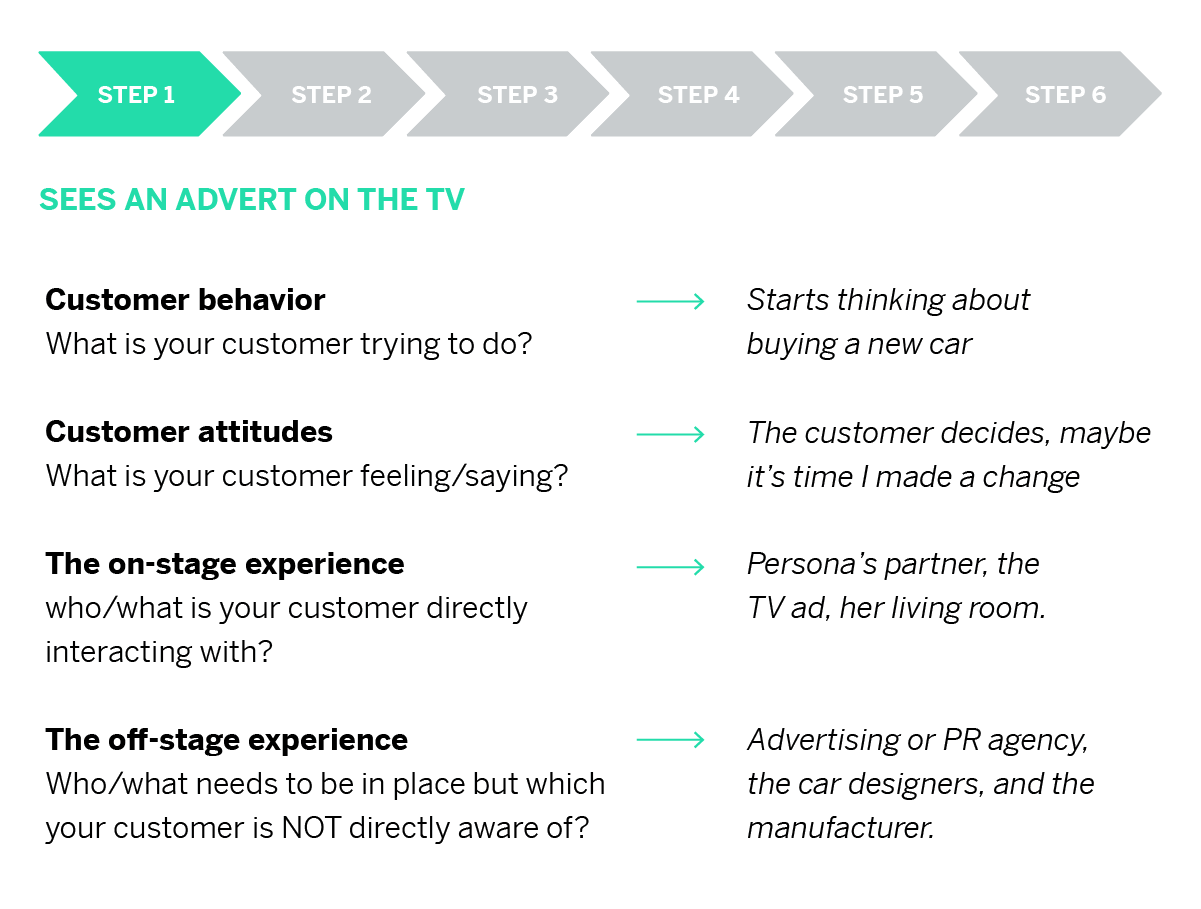
One customer journey map, for example, might start with a TV ad, then utilize social media and third-party review sites during the consideration stage, before purchasing online and then contacting customer support about you your delivery service. And then, finally, that customer may be served a discount code for a future purchase. That’s just one example.
Customer journey mapping is really about building a myriad of those journeys that are informed by everything you know about how customers interact with you – and then using those maps to discover weaker areas of the journey.
2. Listen like you mean it
The key to building better customer journeys is listening to what customers are saying. Getting feedbac k from every stage of the journey allows you to build a strong, all-encompassing view of what’s happening from those that are experiencing it.
Maybe there’s an issue with the customer sign-up experience, for example. Or maybe the number advertised to contact for a demo doesn’t work. Or maybe you have a customer service agent in need of coaching, who only makes the issue worse. By listening, you’ll understand your customers’ issues and be able to fix them at the source. That customer service agent, for example, may just feel disempowered and unsupported, and in need of the right tools to help them perform better. Fixing that will help to optimize a key stage in the customer journey.
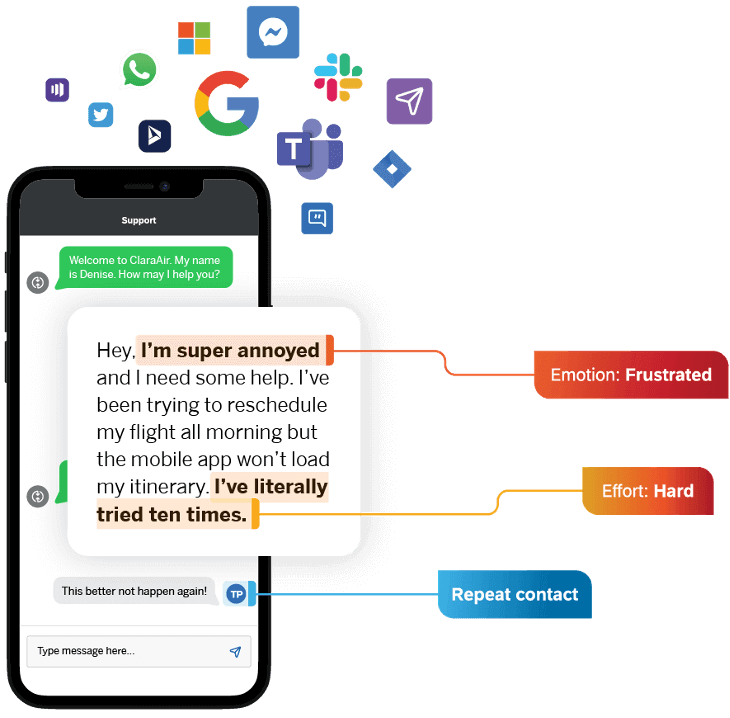
The key is to listen at every stage, and we can do that by employing the right technology at the right customer journey stages.
Customer surveys, for instance, can help you understand what went wrong from the people who’re willing to provide that feedback, but conversational analytics and AI solutions can automatically build insights out of all the structured and unstructured conversational data your customers are creating every time they reach out, or tweet, or leave a review on a third party website.
3. Get personal
The other side of the ‘listening’ equation is that it’s worth remembering that each and every customer’s journey is different – so treating them with a blanket approach won’t necessarily make anything better for them.
The trick instead is to use the tools available to you to build out a personalized view of every customer journey, customer journey stage, and customer engagemen t, and find common solutions.
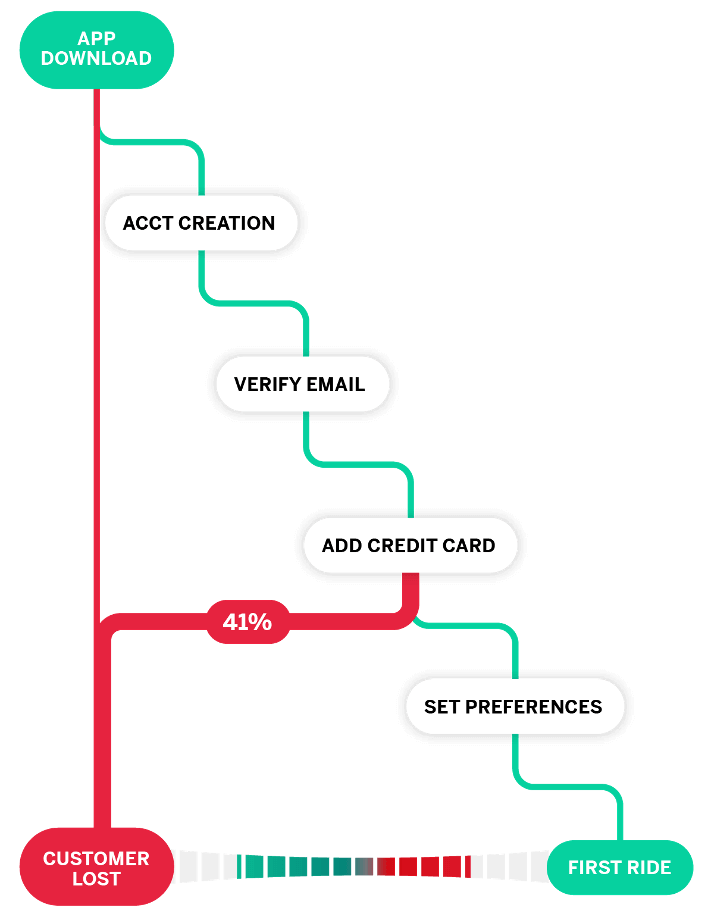
Qualtrics Experience iD , for example, is an intelligent system that builds customer profiles that are unique to them and can identify through AI, natural language processing , and past interactions what’s not working – and what needs fixing.
On an individual basis, that will help turn each customer into an advocate. But as a whole, you’ll learn about experience gaps that are common to many journeys.
Listening to and understanding the customer experience at each customer journey stage is key to ensuring customers are satisfied and remain loyal on a huge scale.
It’s how you create 1:1 experiences, because, while an issue for one person might be an issue for many others, by fixing it quickly you can minimize the impact it might have on future customers who’re right at the start of their journey.
Free Course: Customer Journey Management Improvement
Related resources
Customer Journey
Buyer's Journey 16 min read
Customer journey analytics 13 min read, how to create a customer journey map 22 min read, b2b customer journey 13 min read, customer interactions 11 min read, consumer decision journey 14 min read, customer journey orchestration 12 min read, request demo.
Ready to learn more about Qualtrics?

IMAGES
VIDEO
COMMENTS
Cross-device and multiple-channel access of services has made mapping customer journey a tedious task for businesses. In this blog we will discuss the top challenges brands face while mapping their customer journey and the ways to overcome them in 2021: 1. Complex Web of Multiple Channels. Proliferation of multiple channels, devices and ...
A customer journey map helps you gain a better understanding of your customers so you can spot and avoid potential concerns, make better business decisions and improve customer retention. The map ...
A third challenge in customer journey mapping is getting the support and involvement of key stakeholders, such as senior management, sales, product, service, and IT teams. Customer journey mapping ...
A customer journey map is a visual representation of customers' processes, needs, and perceptions throughout their interactions and relationship with an organization. It helps you understand the steps customers take - the ones you see, and don't - when they interact with your business. Customer journey mapping helps you look for the ...
The challenges listed above all indicate a need for more sophisticated journey mapping that can adapt to the complex nature of customer behaviors and business environments. So, with that in mind, let's look at two ways that your journey maps can evolve…. 1. Adding Voice of the Customer insights to journey maps.
Customer journey vs process flow. Understanding customer perspective, behavior, attitudes, and the on-stage and off-stage is essential to successfully create a customer journey map - otherwise, all you have is a process flow. If you just write down the touchpoints where the customer is interacting with your brand, you're typically missing up to 40% of the entire customer journey.
6. Make the customer journey map accessible to cross-functional teams. Customer journey maps aren't very valuable in a silo. However, creating a journey map is convenient for cross-functional teams to provide feedback. Afterward, make a copy of the map accessible to each team so they always keep the customer in mind.
8 effective customer journey mapping best practices. Put these eight proven strategies into action to create an amazing buyer journey map that helps you elevate the user experience (UX): 1. Set clear goals. Before taking any action, define what you hope to achieve from your customer journey map. Following specific objectives throughout the ...
Define the map's scope (15 min) Ideally, customer journey mapping focuses on the experience of a single persona in a single scenario with a single goal. Else, the journey map will be too generic, and you'll miss out on opportunities for new insights and questions. You may need to pause creating a customer journey map until you have defined your ...
Challenges of customer journey mapping. Creating an accurate customer journey map can be challenging, as it requires gathering customer data from multiple sources and understanding customer needs and preferences. It can also be difficult to create an actionable strategy to address customer pain points, as different customers may have different ...
1) To identify moments of truth with customers. 2) To assess the customer's perception of your performance. 3) To provide an end-to-end perspective of the journey, they have with your company. 4) To help you rationalize new projects and provide a foundation for developing a digitally enabled future-state experience.
The customer journey map may be a reference point for new campaign concepts, messages, techniques, and more. Challenges of Omnichannel Customer Journey Mapping. While the opportunities ensured by customer journey mapping seem very bright, there are also some challenges and limitations to consider: Automation Challenges
Step 4. Mapping the customer's emotional journey: Understand and document the emotional highs and lows that customers experience. Step 5. Identifying moments of truth: Pinpoint critical decision-making points or "moments of truth" in the customer journey.
What are the challenges of customer journey mapping? Customer journey mapping can be a quick and easy process—take a look at our guide to creating a CJM in 2.5 days—but it comes with some challenges: You need a strong understanding of all your customer profiles and user groups to avoid leaving anyone out. Don't rely on assumptions: run ...
Customer journey maps are visual representations of customer experiences with an organization. They provide a 360-degree view of how customers engage with a brand over time and across all channels. Product teams use these maps to uncover customer needs and their routes to reach a product or service. Using this information, you can identify pain ...
The very process of creating a journey map forces people within the organisation to clarify and agree on what the customer experience is and how the organisation delivers that experience. That clarification includes consistent definitions of what happens in each part of the process. In our Customer Journey Mapping workshops I often hear participants exclaim they "didn't know that's what ...
Customer journey mapping techniques are valuable tools for measuring customer experience effectiveness. These maps illustrate the steps customers go through, providing a visual representation of their experience. By mapping out the touchpoints and interactions at each stage, you can identify pain points and opportunities for improvement.
An omnichannel customer journey map visually depicts a customer's interactions with a brand across all touchpoints, channels, and devices. It presents a comprehensive picture of the customer journey, taking into account both online and offline encounters and emphasizing the possibilities, challenges, and crucial moments that might have an ...
This Miro template features a comprehensive customer journey map. It helps teams capture key goals, struggles, actions, touchpoints, and customer feelings. Miro enables collaborative editing and brainstorming to support the process. It makes the mapping exercise highly interactive and efficient.
The first step is to develop a holistic view of the customer experiences and their connections with all the company's channels. Journey mapping helps demonstrate the whole experience throughout a sequence of touchpoints, making it possible to understand how customers feel when the results are related to the company's data, processes ...
3. Smaply. Smaply is a mapping tool for complex customer journeys, helping you understand channel usage and backstage processes. It lets you create a repository of customer insights, including images, PDF files, and even audio files to link all your data together and get a full overview of the customer journey.
5 Challenges With Customer Journey Mapping. 1. Underplaying the Importance of CJM. Customer journey mapping is more than a strategic exercise. It's more than a workshop. It's a critical tool that gives you deep visibility into how people are finding your brand, interacting with your content, and ultimately, making a purchase.
Note: Gaining this insight will help brands to take steps to provide instant 24X7 live-chat/ video-conferencing options.Conversational bots may address basic questions and forward complex queries ...
Track your brand performance 24/7 and act quickly to respond to opportunities and challenges in your market. XM Platform. Explore the platform powering Experience Management. Free Account Watch Demo ... Perform customer journey mapping. A customer journey map takes all of the established customer journey stages and attempts to plot how actual ...